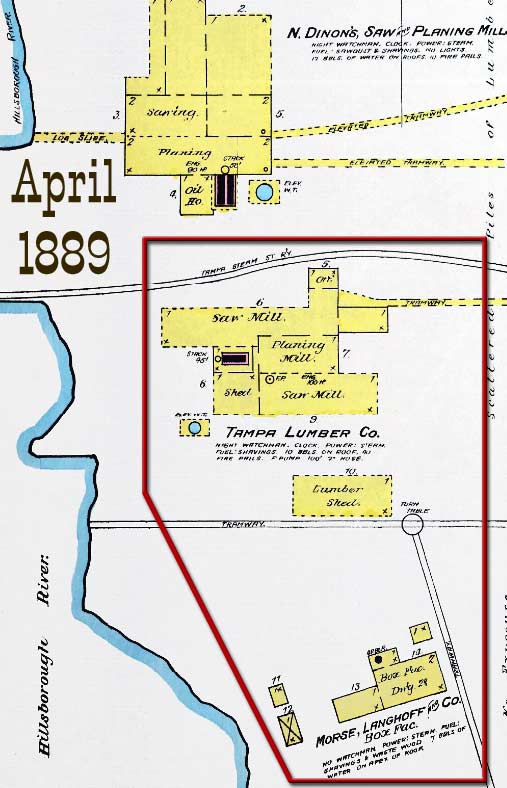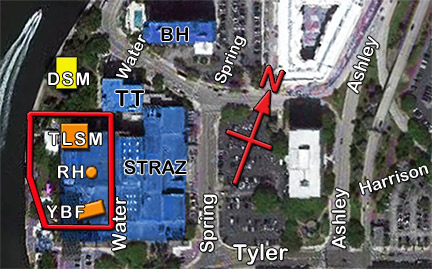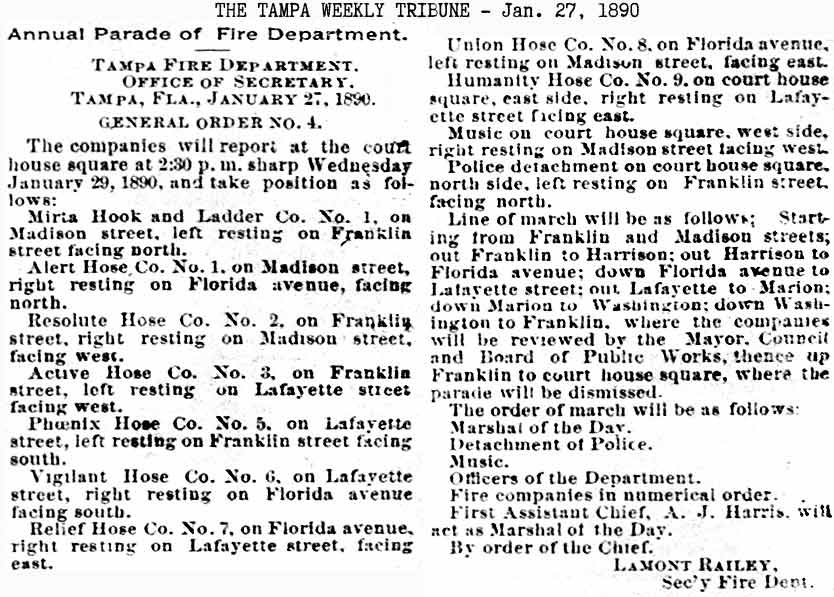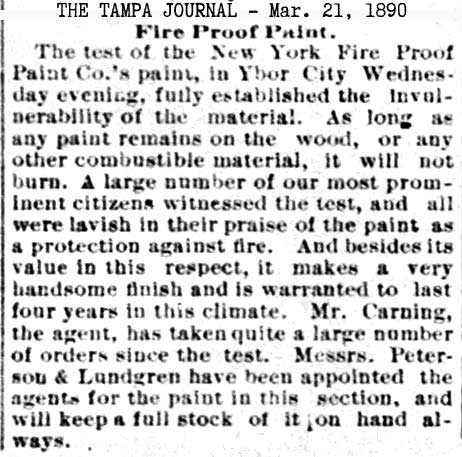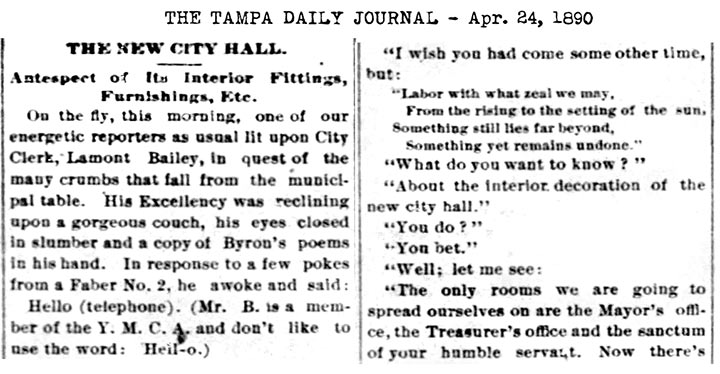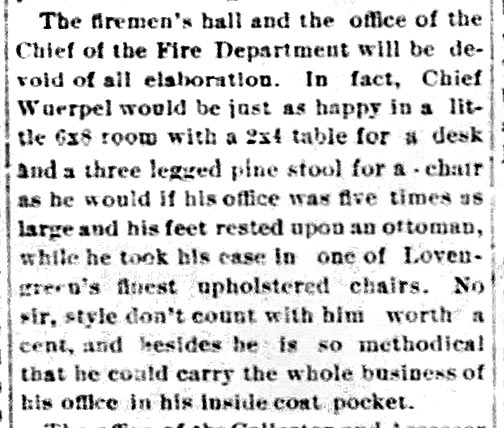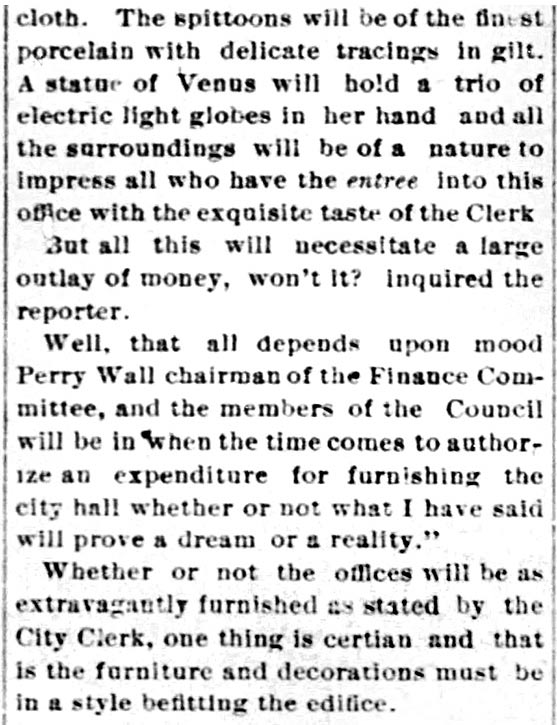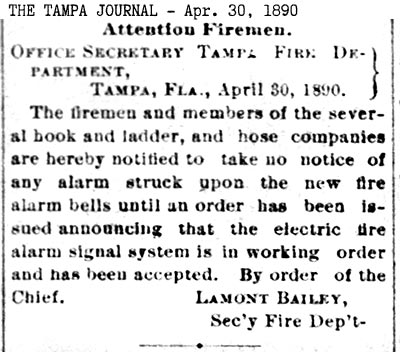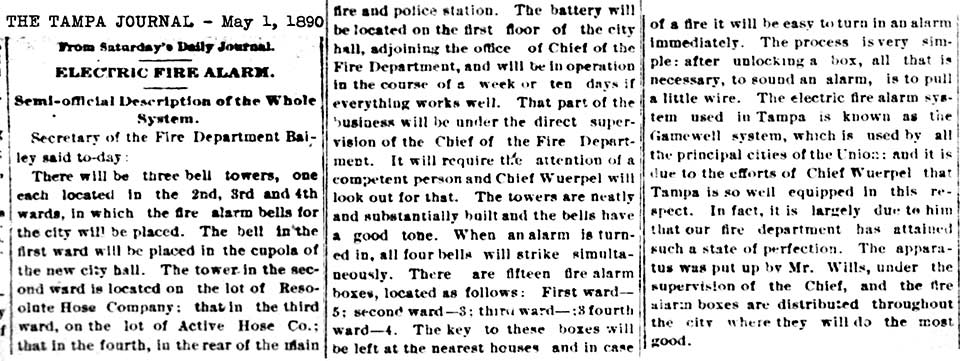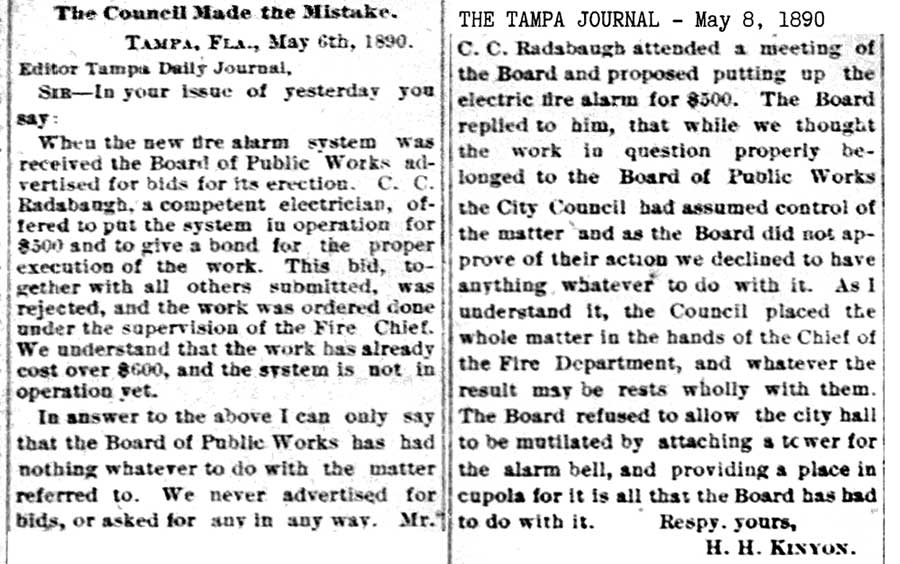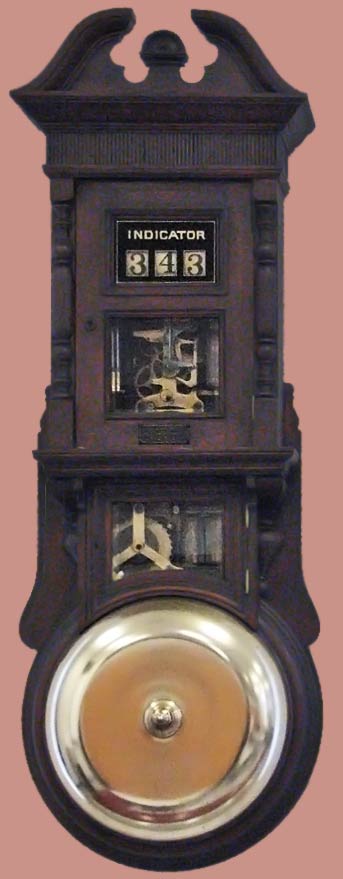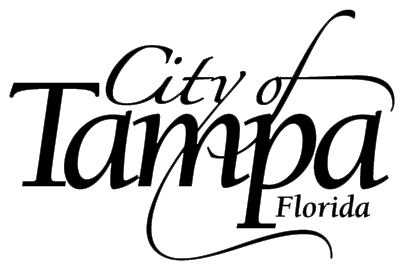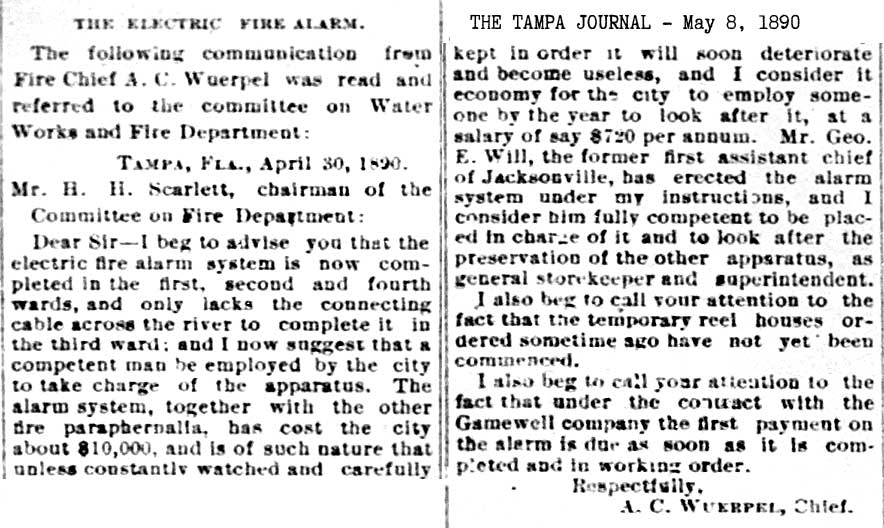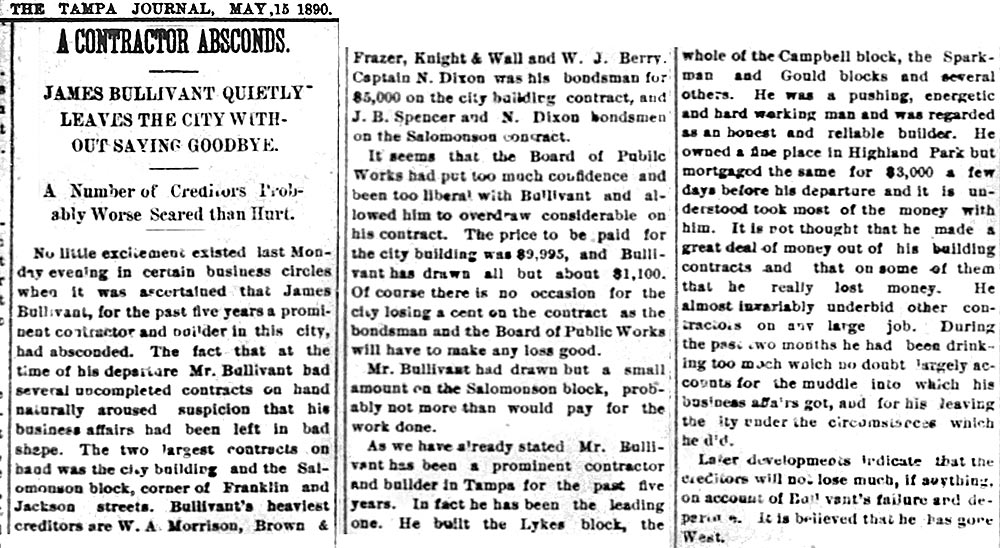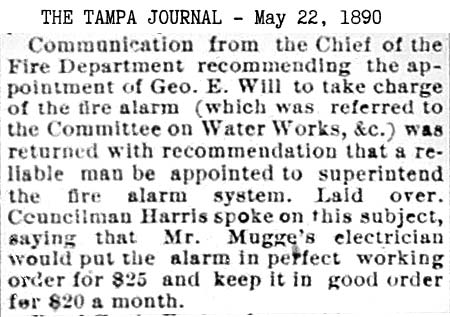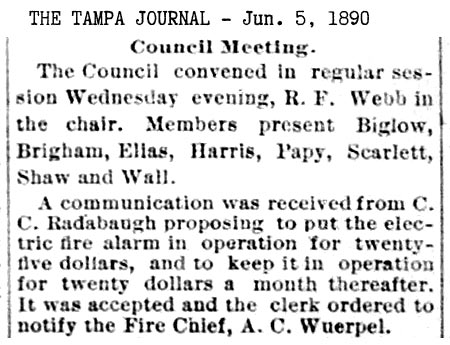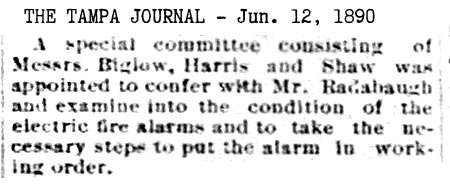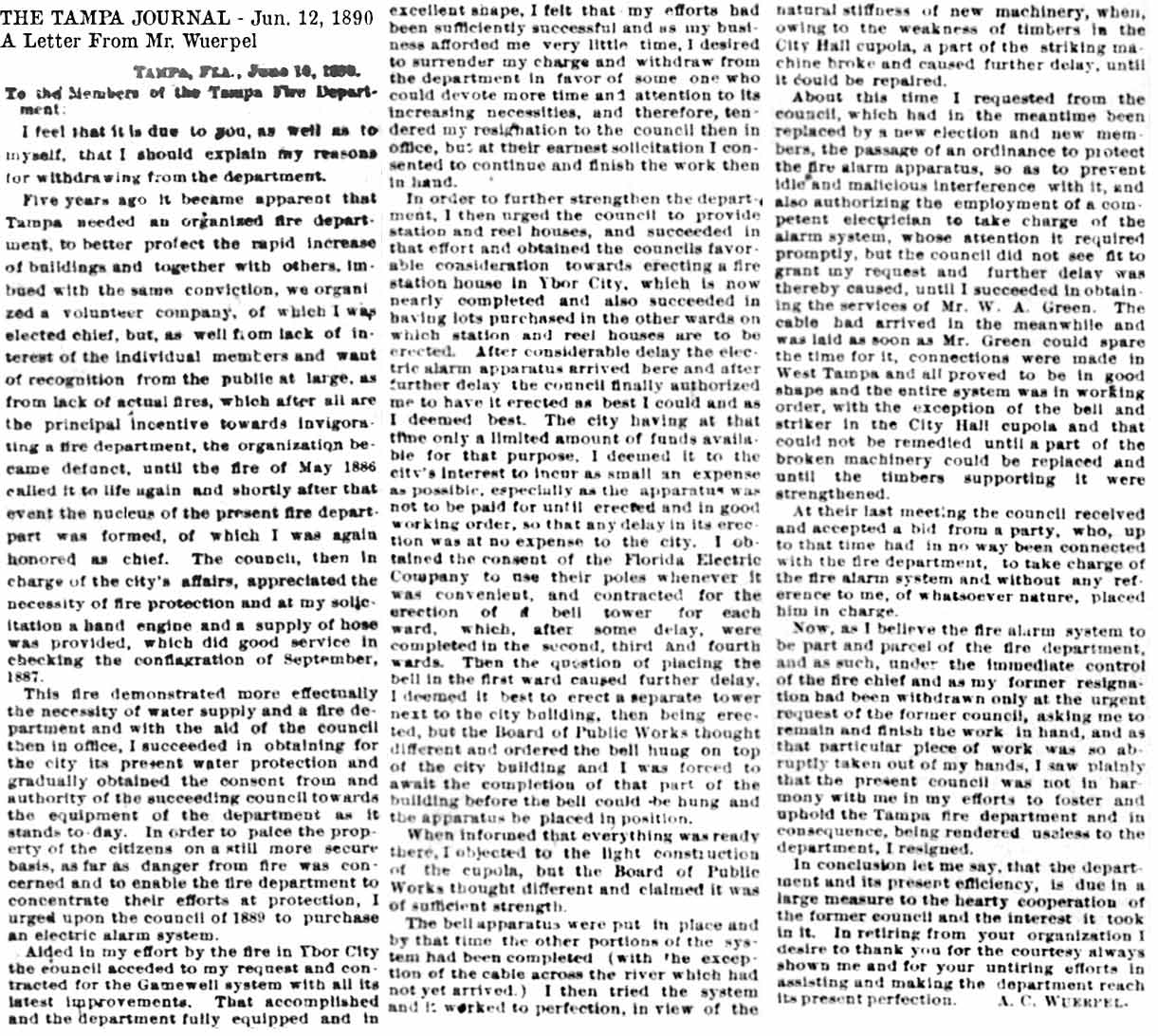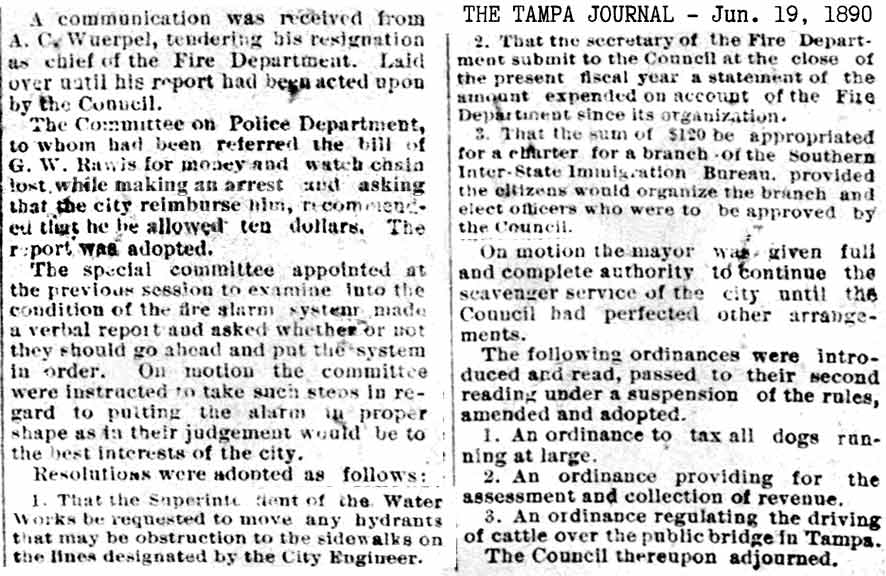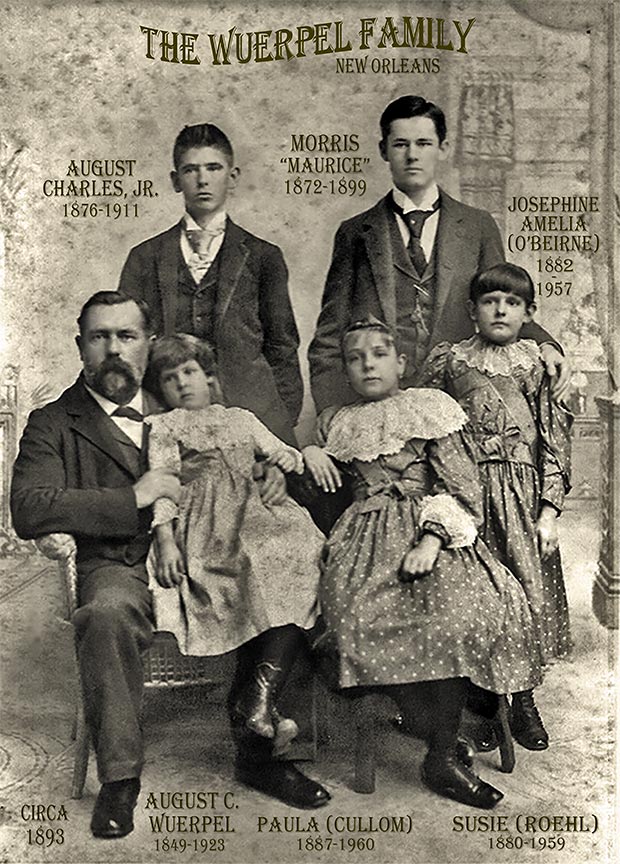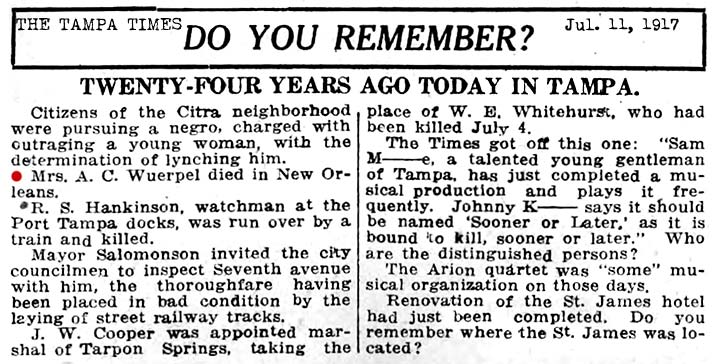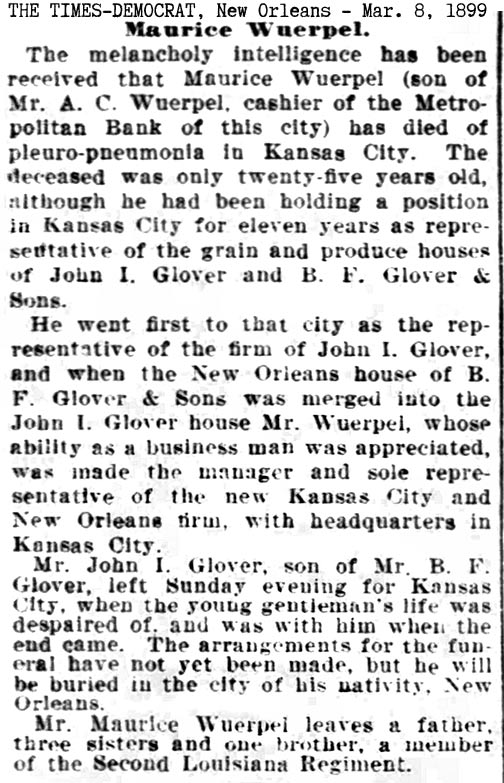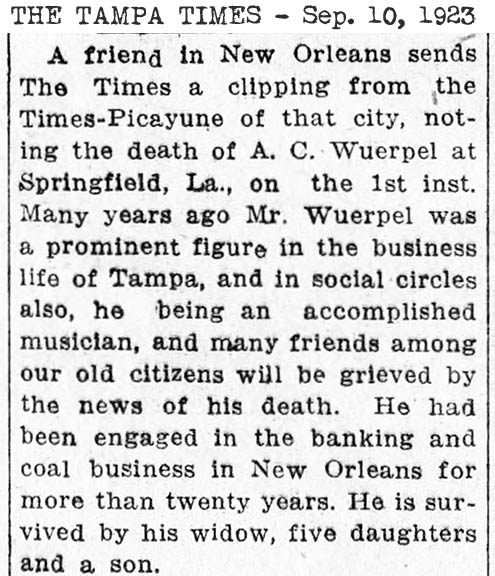|
Tampa's First
Fire Chief - Augustus C. Wuerpel
This page is in the
process of being updated.
|
August C.
(Charles/Karl) Wuerpel was born July 11, 1849 in
Cologne, (Leichlingen, Rheinland, Preußen) Germany. He
was 11 years old when he and his three sisters
immigrated to America with their parents in 1860.
Father: Morris
(Moritz) Wuerpel b. 1801 Amsterdam, Noord-Holland d.
1865 St. Louis, Mo.
Mother: Adelheide
Trolle Wuerpel b.1805 Haute-Normandie, France, d. 1888
St. Louis, Mo.
The Wuerpels came
to America on the steamer Bavaria which
departed from the port of Hamburg, GER, stopped in
Southampton, ENG and arrived at the Port of NY on Sept.
3, 1860 |
|
The
Wuerpels settled in St. Louis, Missouri where Moritz had
relatives. Moritz and Adelheid Wuerpel are both buried
in Bellefontaine Cemetery St. Louis City, Missouri. |
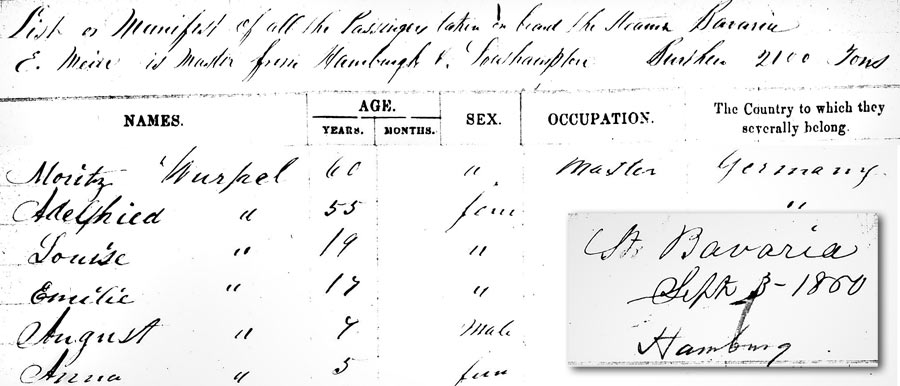 |
|
|
Moritz
(60), Adelhied (Adelaide, 55), Louise (19), Emilie (17), August (7),
Anna (5).
August would have been 11 here, not 7. Moritz's
occupation was listed as "Master." |
|
On Dec.
15, 1869, August married Josephine Amelia Almindinger at
Lafayette Presbyterian or Fulton St Church in New
Orleans. Josie was born in New Orleans in 1847, one of
at least 6 children of German born carpenter Michael J.
Almindinger and his New York-born wife Susan (according
to their 1850 Census in New Orleans, and Susan's 1870
Census in New Orleans.)
|
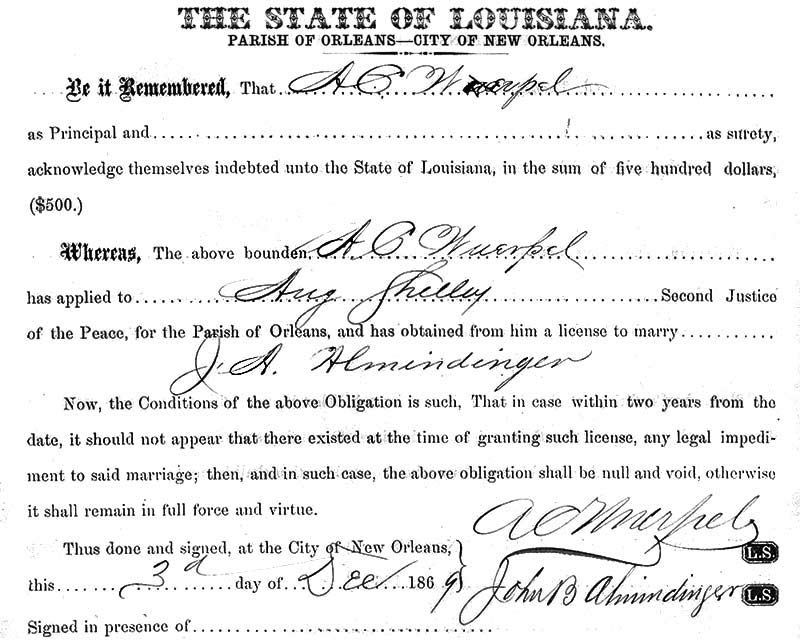 |
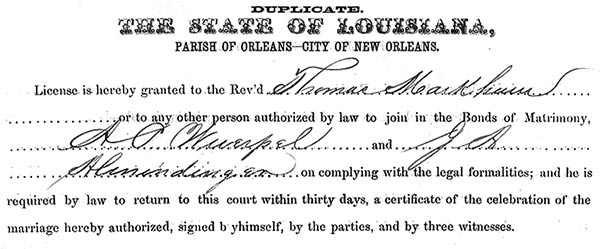
|
|
Their marriage
license was obtained on Dec. 3, 1869. It is
very rare for a New Orleans marriage record
to represent both the bride and the groom
only by their first initials and surnames.
John B.
Almindinger was Josephine's brother.
|
|
1870 Census
of August & Josephine Wuerpel
11th Ward of New Orleans

August was working as a
carpenter. His father, Moritz (Morris)
Wuerpel was a carpenter and builder in St.
Louis.
|
|
Gus was Secretary of the Patent Tile Roofing
Co. in New Orleans |
Gus and Josie's first child, Addie, was
probably named for Gus' mother Adelaide
(Troulle) Wuerpel |
|
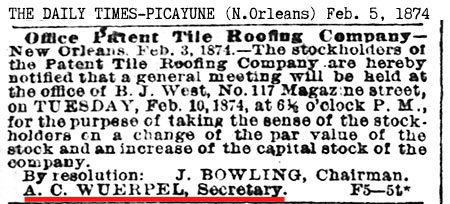 |

Since their oldest son Morris was born in
1872, Addie was probably born in 1871 and
would have been around 7 years old when she
died.
|
|
Announcement of baby girl born
to Mrs. A.C. Wuerpel on Mar. 9,
1880. This was Susie; she
appears on their 1900 census as
"1/4" year old, with her birth
month "Mch" recorded in the next
column. |
|
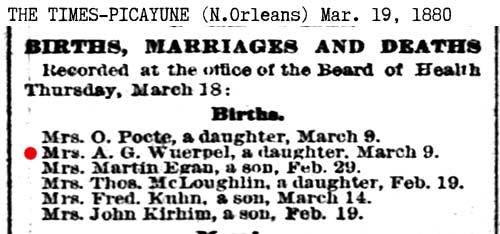
|
The Wuerpels'
1880 census in New Orleans shows Gus was a
bookkeeper. Wife Josephine with children
Morris, Gustave (August. Jr.) Susie, and
Josephine's mother Susan Almindinger
(widowed) was living with them. They also
had a servant and a cook.
It is not
known why Gus Wuerpel's birth place was
given as Mississippi. Perhaps the
information was given by someone in the
household other than Gus. The mistake is
propagated to their children's father's
birthplace. Josephine's parents' census of
1850 in New Orleans shows Josephine had 3
siblings born in Mississippi. Another
inconsistency is Josephine's mother's
birthplace shown as South Carolina. Michael
and Susan Almindinger's 1850 Census shows
Susan was born in New York. Susan shows up
on the 1870 Census in New Orleans living
only with H. Almindinger, who was probably
her son Horace. Again, Susan Almindinger
was listed as born in NY.
1880 Census, New Orleans, La.

The Wuerpels
were living at 235 Chesnut St. in New
Orleans. |
|
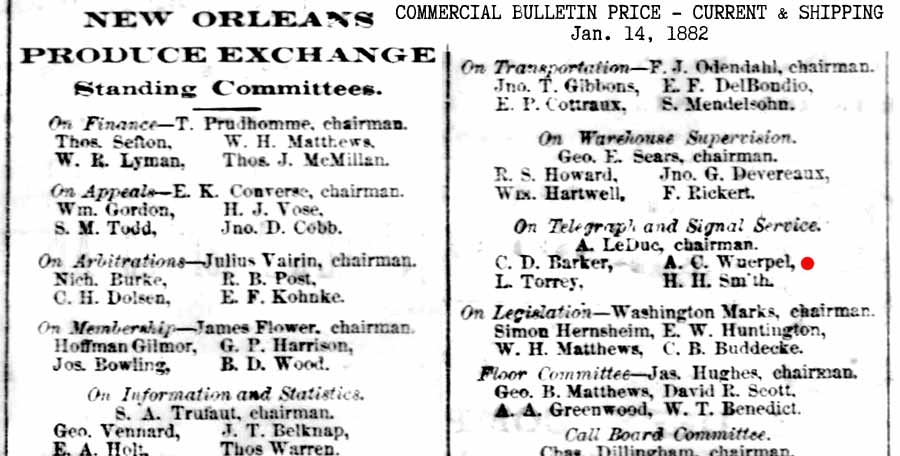 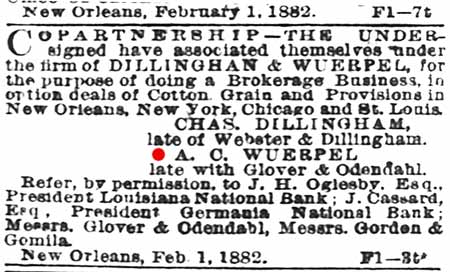
|
The
notices above place A.C Wuerpel still in New Orleans
through Jan. of 1882. Wuerpel, formerly with Gover
& Odendahl, has formed his own brokerage firm in
partnership with Chas. Dillingham, formerly of
Webster & Dillingham.
Evidence that the Wuerpels were still in New Orleans
in Aug. 1882: The Times-Picayune of New Orleans
announced the birth of a baby girl on Aug. 20,
1882, to Mrs. A.C. Wuerpel. This can only be their
daughter Josephine Amelia Wuerpel.
|
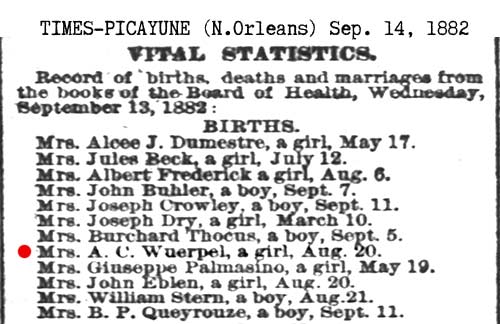 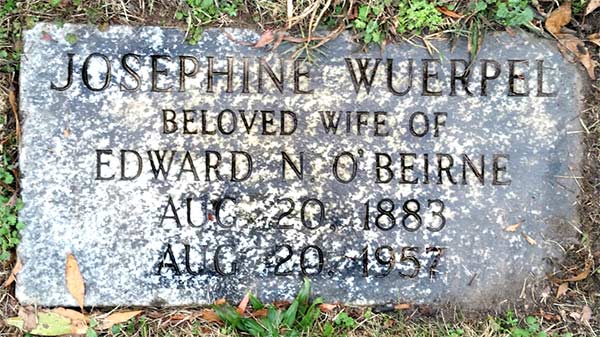
It appears that her 1900 Census
and her tombstone have incorrectly represented her birth year as
1883.
Tombstone photo courtesy of Phil at Find-a-Grave
|
The
cotton and produce broker firm of Dillingham &
Wuerpel went "belly-up" in April 1883. |
Below is the last article published in New Orleans newspapers
containing "Wuerpel" for newspapers online at Newspapers.com.
There are no mentions in 1884. |
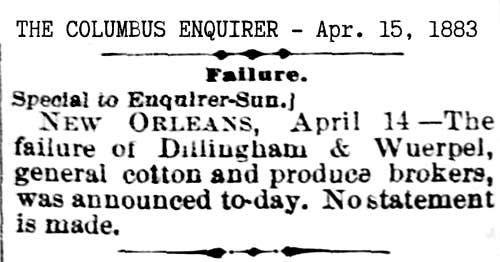 |
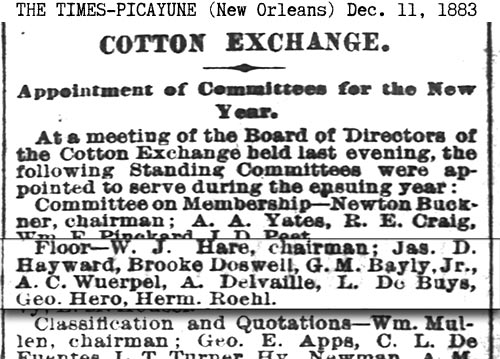 |
It appears that the Wuerpels came
to Tampa in late Dec. 1883 to early 1884.
|
THE
WUERPEL FAMILY IN TAMPA
The
first official record of the Wuerpels in Tampa found
thus far is the 1885 Florida State Census where
August was working as a bookkeeper. A. C. Wuerpel
and his family were listed 5 dwellings away and on
the same page as Tampa merchant John Jackson and
John's son Thomas. This would have been in the
vicinity of Tampa Street, Jackson St. and Washington
St. Using their daughter Josie's age and birthplace,
it would appear they came to Tampa no sooner than
1883.
1885 Florida State Census, Hillsborough County,
Tampa

August
(36), wife Josephine (34), children all born in La.
: Morris (13), August (9), Susie (5) and Josie (3).
Further proof that Josephine (Almindinger) Weurpel's
mother was from NY can be seen on line 34, in the
last column for "mother's birth place."
TAMPA'S
WATER SUPPLY and FIRST FIRE DEPARTMENT
The formation of a dedicated fire
department in Tampa was closely tied to
Tampa's quest for a reliable water
system.
The
information presented here about Tampa's
fire department early history comes
mostly from these sources: June 10,
1890 article in the Tampa Journal, "A
Letter From Mr. Wuerpel" to the members
of the Tampa Fire Dept. Tampa Bay
History magazine at USF Scholar Commons,With
Pride and Valor: The Tampa Fire Fighters
Union. 1943-1979 by Mark Wilkins, South
Tampa Magazine, Hometown Heroes. Grismer,
Karl - A History of Tampa, and a Tampa
Tribune column of Aug. 23, 1959 Pioneer
Florida Chief
soaked in Jackson St. ditch water by
D.B. McKay. (Click the link to see
entire article, then click the article
to see full size.)
In 1885 it
became apparent to Tampa businessman
August C. Wuerpel, along with other
Tampa citizens, that Tampa needed an
organized fire department. During the
winter of 1884-85, a series of
disastrous fires convinced everyone that
a dependable water supply was essential
and on July 28, 1885, the City Council
awarded a franchise to the Holly
Manufacturing Company, of Lockport,
N.Y. The company agreed to provide
enough water for a town of 10,000 and
install fifty fire hydrants without
charge. Water rates were fixed at $8 a
year for homes and from $15 to $50 a
year for business places.
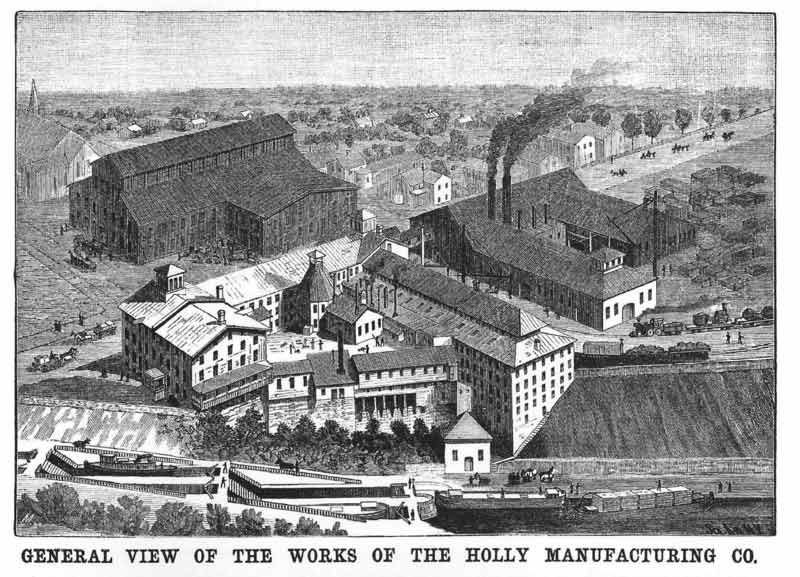
Postcard image from VintageMachinery.org
After
getting the contract, the Holly
officials lost their enthusiasm. Making
a house-to-house check to learn how many
families would take the "city water,"
they learned they could not expect to
get a gross revenue of more than $1,000
a year. That was not enough to pay
operating expenses, to say nothing of
giving a return on the initial
investment, so they understandably
proceeded to abandon the franchise.
See a more detailed history of Tampa's
Waterworks here at TampaPix.
On June 2,
1884, sixteen local citizens formed Hook
& Ladder Company No.1, a volunteer
department with W. B. Henderson as
foreman, Fred Herman, assistant foreman,
and C. P. Wandell, treasurer. Other
members were P. F. Smith, Dr. Duff Post,
Ed Morris, J. C. Cole, E. L. Lesley,
Phil Collins, S. P. Hayden, Frank Ghira,
H. L. Knight, A. J. Knight, C. L .
Ayres, S. B. Crosby and A. P .
Brockway. In 1885, A.C. Wuerpel was
appointed to be the department Chief.
[Grismer, A
History of Tampa, 1959]
Meanwhile,
repeated attempts were made to interest
other water companies to build Tampa's
water works, but all failed because
Tampa, then a non-incorporated town,
could not obligate itself to pay for
water hydrants.
[Grismer, A
History of Tampa, 1959]
Due to a
relative lack of fires, lack of interest
of the members and their desire for
public recognition, the fire-fighting
organization became defunct. Disastrous
fires of 1885 and May 1886 caused
interest to revive the fire department*
and Wuerpel was chosen as its chief with
seven "bucket brigades" organized to
serve the city.
[Grismer, A History
of Tampa, 1959, *A. C. Wuerpel
resignation letter of Jun. 10, 1890]
The only
equipment these firemen had consisted of
twenty buckets, two scaling ladders and
some axes. In these early days,
dependence for water to fight fires in
the heart of the business district was
on public wells located at various
intersections, and the Jackson Street
ditch. Bucket brigades carried the
water to the site of the fires.
[Grismer, A History
of Tampa, 1959]
May 12, 1886 Fire
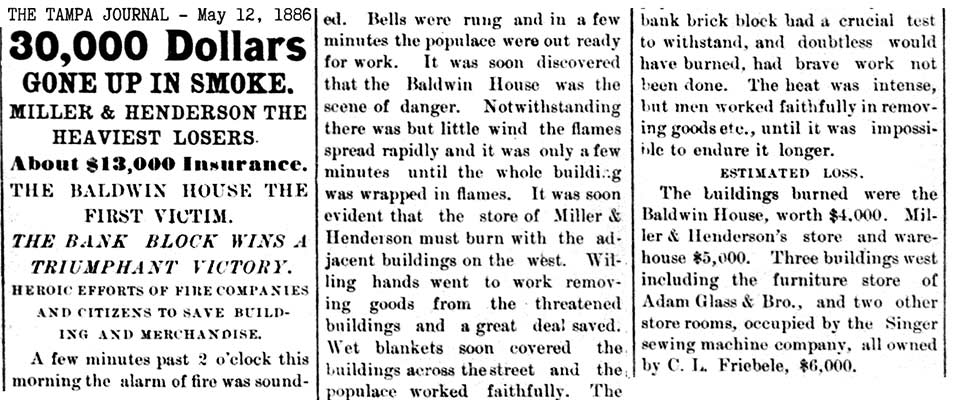
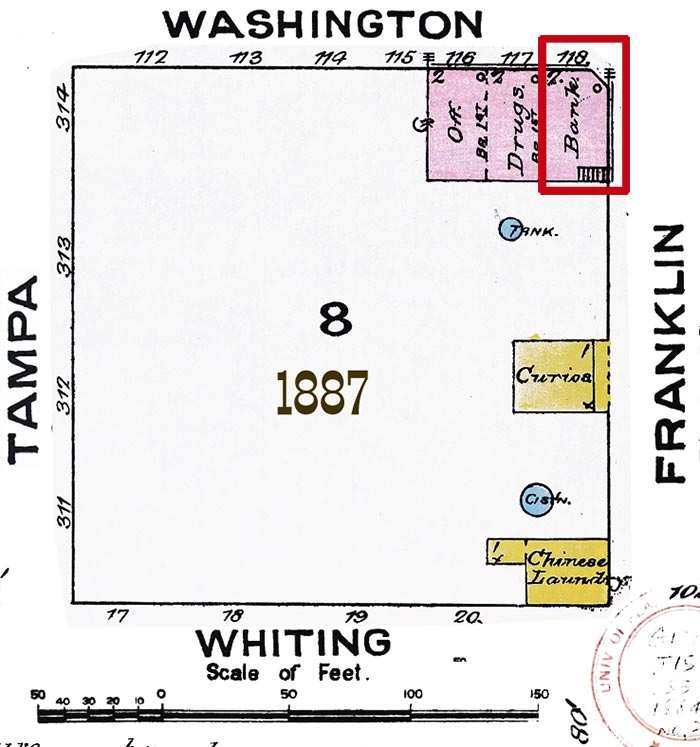
1887 -
After the May 12, 1886 Baldwin house
fire. Pink indicates brick structures,
yellow are wood frame structures.
Needless
to say, more than a little difficulty
was encountered in batting serious
conflagrations. This was clearly shown
May 8, 1886, when all the buildings
except the First National Bank were
wiped out in the block bounded by
Franklin, Whiting, Tampa and
Washington. Included among the
structures destroyed were two buildings
owned by W.P Henderson, a new store of
Friebele & Boaz, the Baldwin House, the
furniture store of A. Glass & Bros., and
the warehouse of Miller & Henderson. The
loss was estimated at $30,000.
PLACE YOUR CURSOR ON THE MAP TO SEE THIS
BLOCK IN 1884, before the fire.
The First
National Bank first started as the Bank
of Tampa, seen below in 1886, it's
second building. It became First
National when it moved to their new
4-story building at 416 Franklin St. on
the southwest corner of Madison St.
around 1900.
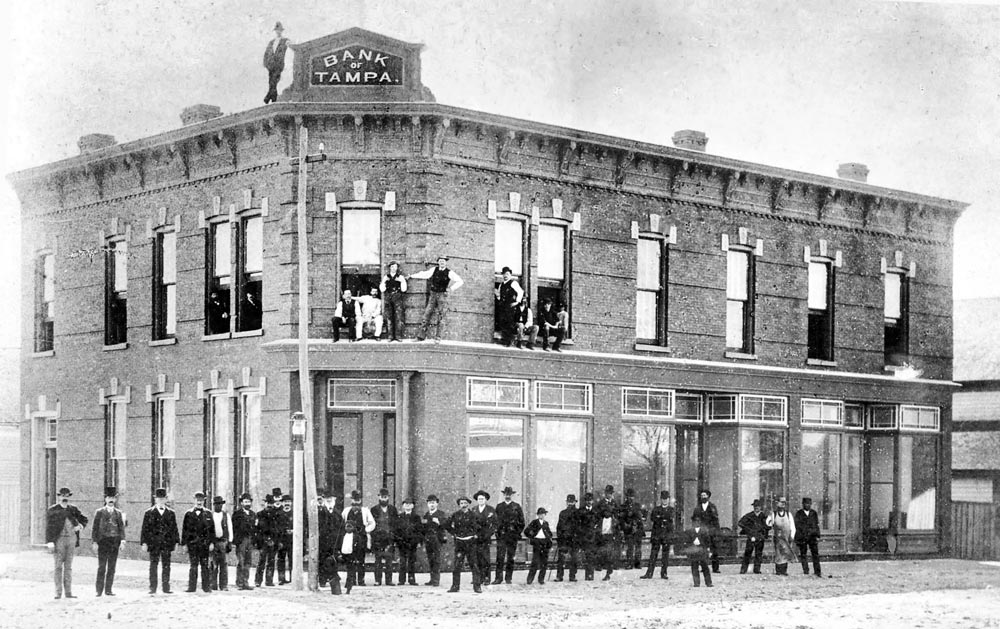
Burgert Brothers photo courtesy of the
USF Library Digital Photo Collections
See the
image there uncropped; there is an
extremely large U.S. flag on an approx.
25 ft. tall flag pole
which can faintly be seen atop the
building.
|
|
The
Mugge Pumper
Immediately after this fire Wuerpel
and Tampa's leading citizens
convinced the town council that it
would be wise to invest in a fire
engine so a $600 "hand pumper" was
ordered. Paid for by successful
liquor dealer Robert Mugge, it
became known as the "Mugge Pumper."
It arrived July 30, 1886 along with
350 feet of two-inch hose and a hose
reel. Almost everyone in town
turned out the next day to see the
engine tested. The hose was run down
to the river and six of the
strongest firemen began laboring on
the pumps. The results were a
splendid-a stream of water which was
thrown clear over the top of John T.
Lesley's two story building at
Franklin and Washington.
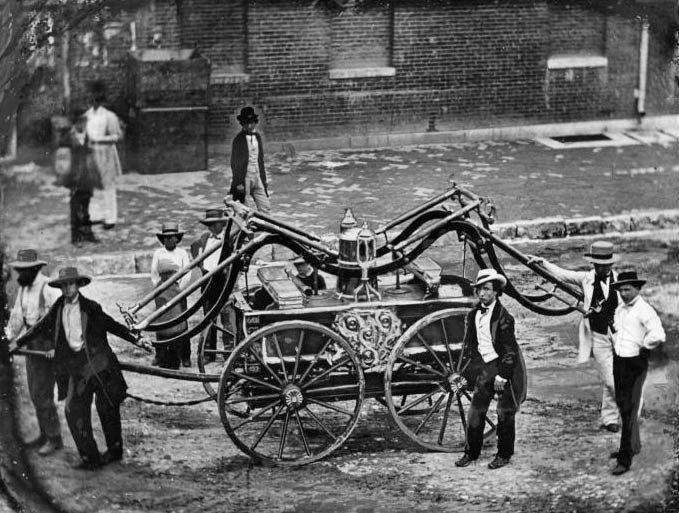
Example of a hand-drawn pumper truck
which could be powered by six
firemen.
Image from "Hand Pumped Fire
Engines" by Flags Up at Pinterest
TAMPA FIRE COMPANY ORGANIZED,
Aug. 30, 1886
To make effective use of the new
equipment, the Tampa Fire Company
was on organized August 30, 1886,
with A. C. Wuerpel as president,
Robert Mugge as secretary, and
Herman Glogowski as treasurer.
Other members were G. B. Sparkman
(later the City of Tampa's first
mayor and judge of the circuit
court}, Odet Grillon, H. Hearquist,
C . O. Pinkert, John R. Jones, Leon
Dartize, Charles G. Lundgren, J. O.
Nelson, Vicente de Leo, and Ernest
Gerstenberger.
These men, and the members of the
Hook & Ladder Company, served
without pay. The new hand engine
and supply of hose did some good in
the fire of Sept. 1887.** But that
fire showed the necessity of a
reliable water supply and again the
council was receptive to equipping
the department as it stood at this
time.
**Allusion
to this fire comes from A.C.
Wuerpel's resignation letter of June
1890. "The council, then in charge
of the city's affairs, appreciated
the necessity of fire protection and
at my solicitation a hand engine and
supply of hose was provided, which
did good service in checking the
conflagration of September, 1887"
No other mention of this fire has
been found in any other available
resources. Although the images of
the four Tampa Weekly Journals for
September 1887 and the first one in
October are extremely faded and
almost completely illegible, enough
can be discerned to conclude that
the only fire mentioned was one in
Sanford, Fla. on Sept. 22nd.
During the next two years the fire
men did the best they could with the
hand pump engine. It served fairly
well when the fire was near the
river but was useless, of course, if
no adequate water supply was close
at hand. Many buildings burned to
the ground which could have been
saved if water had been available.
Everyone rejoiced, therefore, when
the waterworks company announced
that water soon would be turned into
the mains. |
|
The first mention of A.C. Wuerpel in
Tampa newspapers is this Sep.1, 1887 ad
with Pres. Wm B. Henderson and A.C.
Wuerpel as manager of Tampa Commercial
Company Wholesale Grocers, one of the
businesses which demanded his time as he
alluded to in his resignation letter.
Ads for this company with him as manager
appeared almost daily in the Journal and
this was likely his main source of
income. The last ad to name him in this
position was published in the Tampa
Journal on June 25, 1891. |
A. C. Wuerpel was also the manager of
this steamship company which was
probably another Wm. B. Henderson
business venture. |
|
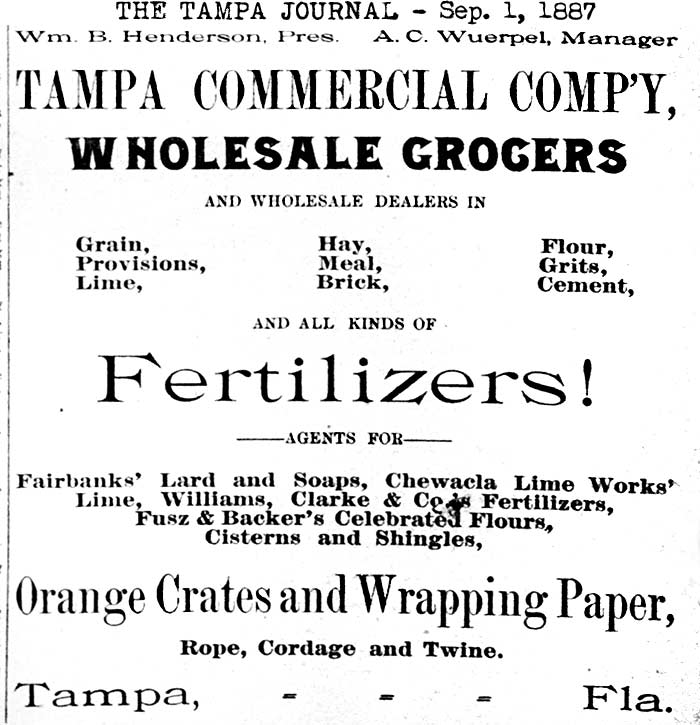 |
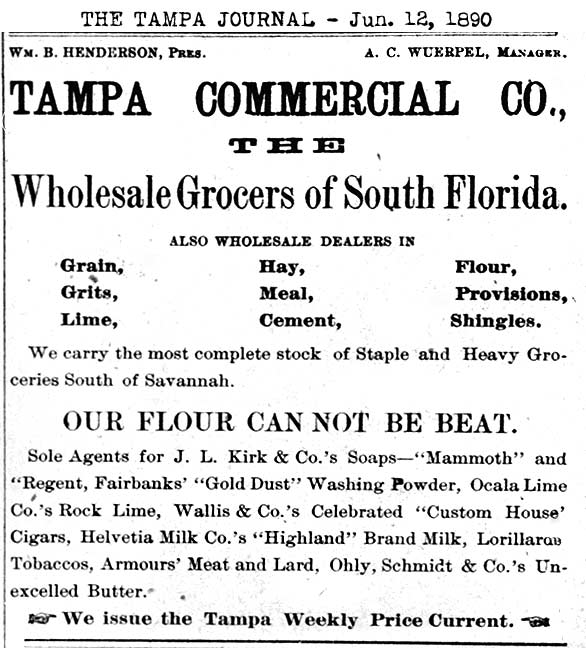 |
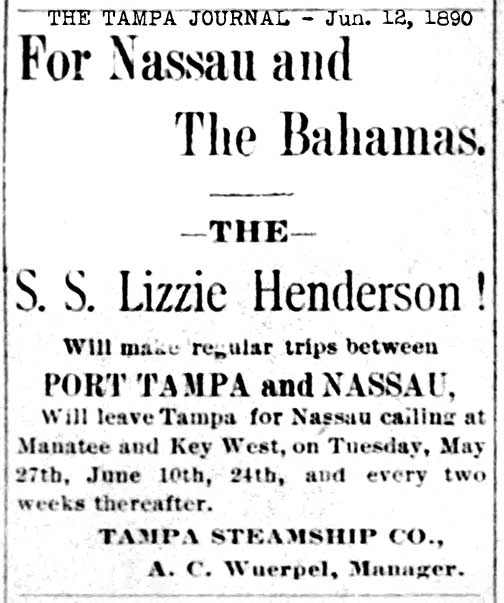 |
|
THE CITY
OF TAMPA ESTABLISHED - JUNE 2, 1887
 The
City of Tampa was established on Jun 2,
1887 when under special act of the state
legislature, the Governor approved a
bill that granted the city of Tampa a
new charter, abolishing the town
governments of Tampa and North Tampa.
Section 5 of the charter provided for a
city-wide election for mayor, eleven
councilmen and other city officials, to
be held on the 2nd Tuesday in July. The
new charter also greatly expanded the
corporate limits of the city. Tampa now
took in North Tampa, Ybor City and some
land on the west side of the
Hillsborough River. The
City of Tampa was established on Jun 2,
1887 when under special act of the state
legislature, the Governor approved a
bill that granted the city of Tampa a
new charter, abolishing the town
governments of Tampa and North Tampa.
Section 5 of the charter provided for a
city-wide election for mayor, eleven
councilmen and other city officials, to
be held on the 2nd Tuesday in July. The
new charter also greatly expanded the
corporate limits of the city. Tampa now
took in North Tampa, Ybor City and some
land on the west side of the
Hillsborough River.
The
first city election under the new
charter was held July 12, 1887, and the
new mayor, Georg Bascom Sparkman, took
office on July 15, 1887, the date
considered to be when Tampa was
organized.
It was
a bitterly fought and controversial
election, accompanied by deplorable
behavior on the part of many Tampa
citizens.
City Clerk
Lamont Bailey's notes of the July 15,
1887 City Council meeting.
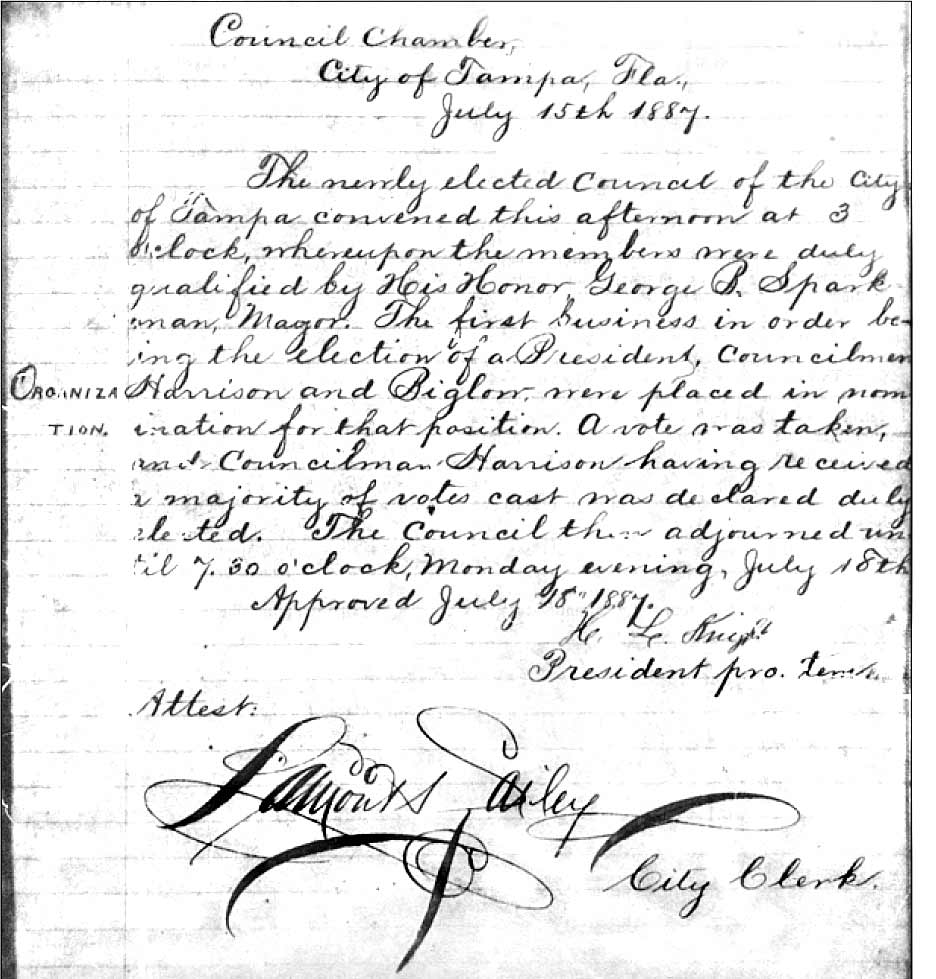
Image from THE
SUNLAND TRIBUNE, Journal of the
TAMPA HISTORICAL SOCIETY,
Volume VIII Number 1 November, 1982 - WHAT
HAPPENED IN TAMPA ON JULY 15, 1887 OR
THEREABOUTS by Joseph Hipp
Read more about this election and what
else was happening in Tampa at this time
here at TampaPix
|
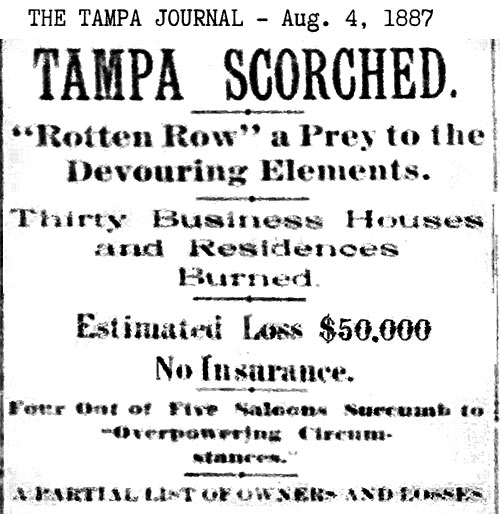
This article is transcribed
here in its entirety due to
the poor quality of the
scanned image. |
THE FIRE AT "ROTTEN ROW"
on Aug. 4, 1887
About two o’clock this
morning a fire broke out
near the center of what is
known as “Rotten Row,”
composed entirely of one and
two story wooden buildings,
and occupied mostly by small
tradesmen such as fruit
stalls, retail groceries,
barber shops, etc. on one
side of the street, and
principally by saloons on
the the other. The fire
seems to have originated
either in Cole’s restaurant
or Thomas’ barber shop, the
flames spreading rapidly
each way from the starting
point and soon enveloping
the entire block in flames.
It was some time before any
kind of effort could be made
to control the fire, and for
a time it looked as though
the whole business part of
the city must surely go, and
the absence of any wind was
probably what saved the best
portion of it. The fire
department, however, soon
got down to business, and by
the almost superhuman
efforts of the firemen the
flames were prevented from
being communicated to the
buildings across Lafayette
street, extending north,
thus saving the Opera house,
Gunn & Seckinger’s large
grocery store and other
valuable business blocks. It
was the prevailing opinion
that nothing could be done
to save the buildings on
either side of Franklin
street between Lafayette and
the ditch, and all the
efforts of the firemen were
directed to preventing the
spread of the flames to the
adjoining blocks, and that
they were successful in this
measure was certainly not
due to the completeness of
our water works system, but
to the untiring efforts of
the people. |
|
The old hand engine did good
service as long as water
could be had, when bucket
brigades were formed and the
sides of the buildings kept
thoroughly drenched. By 4:30
o’clock the two blocks above
mentioned were burned to the
ground, very little of the
contents being saved,
although the utmost good
will prevailed, and
everybody did what they
could to assist their more
unfortunate neighbors.
THE FIRE
The Journal deeply
sympathizes with all who
lost their property in last
night’s conflagration. But
aside from the hardship
entailed upon those who
directly suffered loss, the
effect upon the city can not
fail to be otherwise than
beneficial. Two of the
finest business blocks in
the city are now open for
substantial and valuable
improvement. The real value
of these blocks this morning
is greater than it was
yesterday; and we believe
that within one year from
this date, instead of the
former shanties that stood
yesterday as an eyesore to
the citizens of Tampa, will
tower magnificent brick
blocks.
Read more about this fire at
TampaPix's feature, The
2nd Lafayette St. Bridge.
|
Place your cursor on the map
to see it in 1889
LAFAYETTE ST.
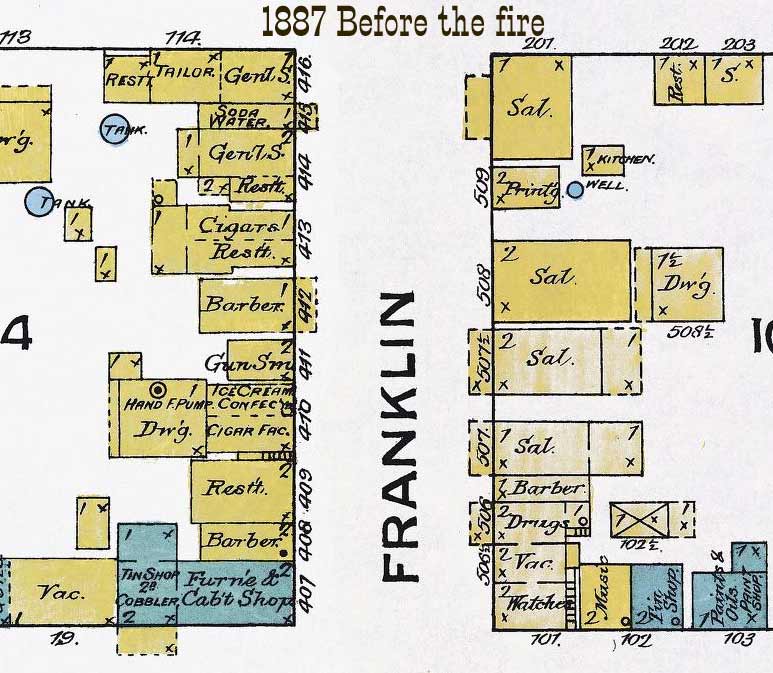
JACKSON ST
|
|
Articles from the Digital
Library of Georgia -
Historic Newspapers |
|
|
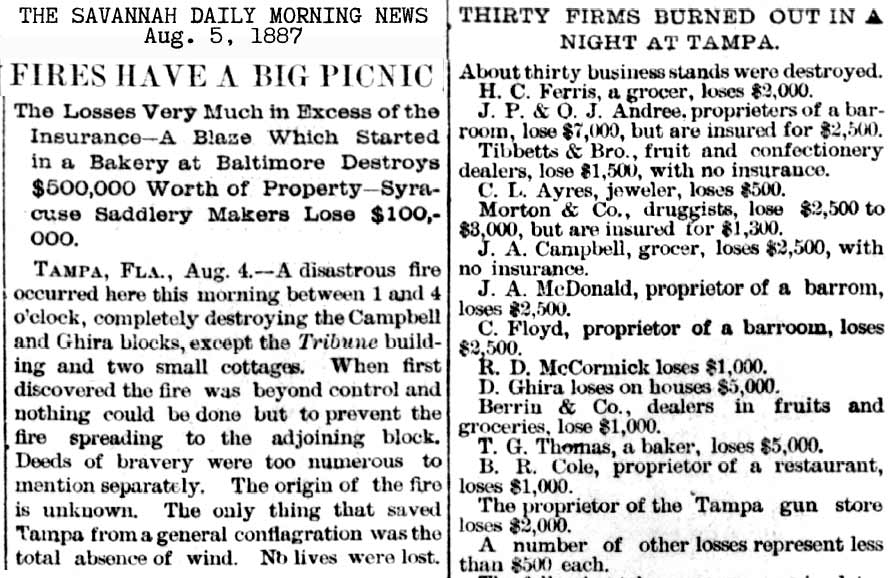 |
BELOW: The Tampa
Savings Bank at
Tibbetts Corner
in 1888-89,
looking
southwest from
the intersection
of Franklin St.
(on left) and
Lafayette (on
right).
Notice the
barber pole on
the street, left
of center of
photo. The
Tibbetts
confectionery is
where the awning
is just left of
the pole.
|
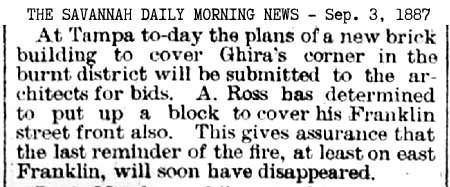
On the 1889 map
above, this was
the west side
(left side) of
Franklin St. at
Lafayette with
Tibbetts and the
barber shop
outlined in
yellow.
Burgert
Bros. photo
below courtesy of the USF Library
digital
collection. |
|
|
|
|
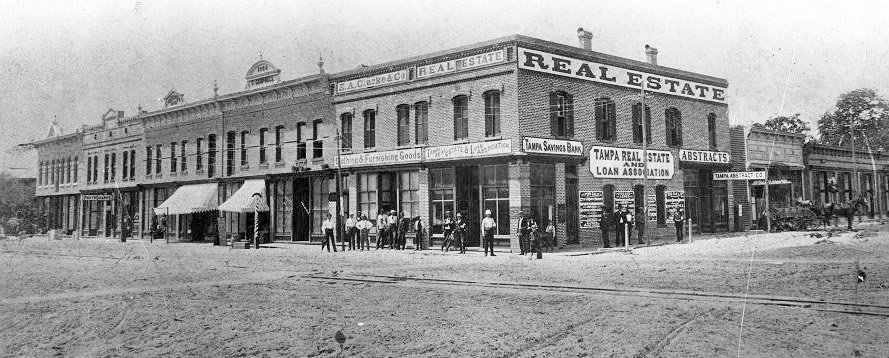 |
|
|
THE NEW
CITY OF TAMPA IS DIVIDED INTO FOUR WARDS
One of
the first acts of the new Tampa city
government was the passage of an
ordinance on September 6, 1887 dividing
the city into four wards. The old town
of Tampa became the First Ward, North
Tampa the Second Ward, West Tampa the
Third Ward, and Ybor City the Fourth
Ward. Ybor City agreed to enter the city
on the strength of promises that Tampa
soon would get a water system, an
organized fire department, electric
lights and paved streets.
Preparations for drilling artesian wells
were starting late in the summer 1887.
On September 13, the new city council
awarded a water works franchise to the
Jeter-Boardman Waterworks Company and
agreed to pay $4,500 a year for 110
hydrants. But action on these
improvements and many others was delayed
by one of the worst calamities which
ever befell the city.
|
|
YELLOW FEVER EPIDEMIC IN
TAMPA
Below is from the
University of South Florida
Library 500
Years of Discovering
Florida, 1887 Epidemic in
Tampa, and “A
SNEAKY, COWARDLY ENEMY”
TAMPA’S YELLOW FEVER
EPIDEMIC OF 1887-88 by
Eirlys Barker, and various
newspaper articles from the
period.
Tampa was relatively free of
Yellow Fever from 1871 to
1886, so Tampans were lulled
into the notion that another
large outbreak would not
happen in their city.
However, Charlie Turk of
Ybor City had the dubious
distinction of being the
first person in Tampa to die
of “yellow jack” in 1887.
An alleged fruit smuggler,
he managed a barber shop.
His family contended that he
had contracted the disease
by using a blanket belonging
to an Italian fruit dealer
named Pepe. Pepe, it was
said, had fallen ill with
strange symptoms, but had
recovered and mysteriously
disappeared. While Turk was
still lying ill in Ybor
City, the first case within
Tampa proper occurred on
September 16, when a second
Italian fruit dealer, Louis
Moses, took sick. Other
Italian traders soon
followed. Possibly six
Italians contracted yellow
fever, as did a few of their
American customers.
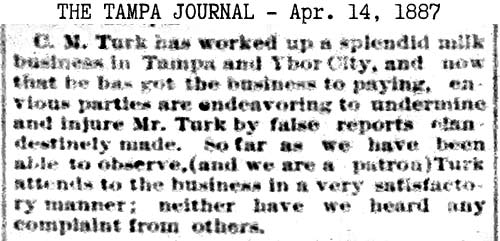 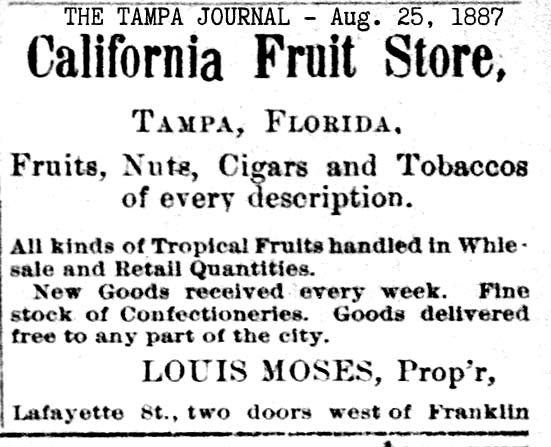
These fruit dealers traded
with citizens from Cuba. The
cargoes of fruit from Cuba
most likely were the
carriers of the infected
Aedes Aegypti mosquitoes.
When the Cubans traded with
the Italians, the infected
mosquito was able to bite
the Tampan man, which led to
the subsequent epidemic.
Turk died in late September;
however physicians were
hesitant to call it Yellow
Fever.
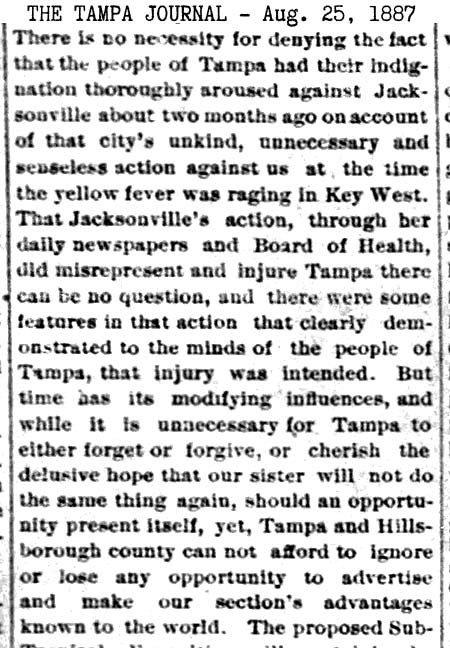 Leading
citizens considered it an
over-reaction to the
situation when Jacksonville
inflicted a quarantine on
all people from Tampa. This
action was protested by the
editor of the Tampa Weekly
Journal, Harvey Cooper, who
claimed that it hurt the
“Hotel Interest.” Cooper
seemed especially concerned
about Henry Plant’s plans
for building a magnificent
hotel at Tampa to attract
thousands of tourists--and
millions of dollars--every
winter. In defense of
this vision, Cooper
sarcastically reported that
the city was no longer in a
state of panic, and “the
people are laughing at their
own foolishness...Only one
death in Tampa since--the
Lord only knows when, and
that occurred last Sunday.
It was a mule. It would be
dangerous for Jacksonville
to lift their quarantine
against Tampa yet awhile." Leading
citizens considered it an
over-reaction to the
situation when Jacksonville
inflicted a quarantine on
all people from Tampa. This
action was protested by the
editor of the Tampa Weekly
Journal, Harvey Cooper, who
claimed that it hurt the
“Hotel Interest.” Cooper
seemed especially concerned
about Henry Plant’s plans
for building a magnificent
hotel at Tampa to attract
thousands of tourists--and
millions of dollars--every
winter. In defense of
this vision, Cooper
sarcastically reported that
the city was no longer in a
state of panic, and “the
people are laughing at their
own foolishness...Only one
death in Tampa since--the
Lord only knows when, and
that occurred last Sunday.
It was a mule. It would be
dangerous for Jacksonville
to lift their quarantine
against Tampa yet awhile."
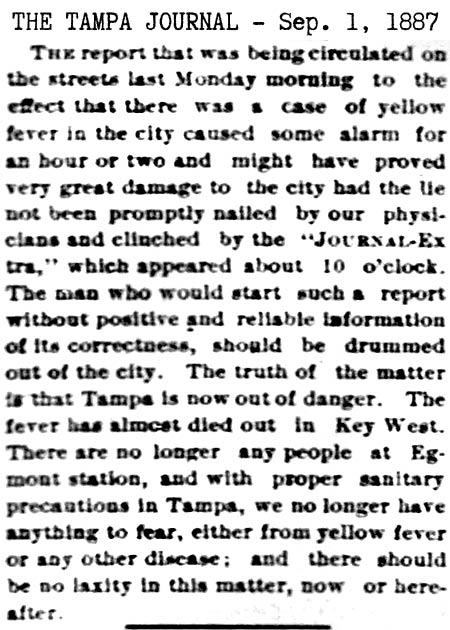
Dr. Wall was out of town
when Turk and Moses had
become sick. When the
physician returned on
the twenty-fifth, the
town was seething with
rumors of the scourge’s
presence. Wall
immediately suspected
the worst.
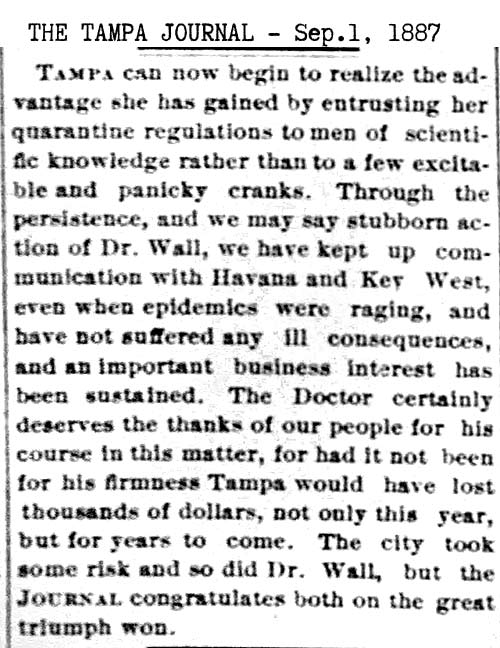 By
September 29, Wall had seen
five suspicious cases,
including two that other
physicians had diagnosed as
bilious remittent fever.
However, he deemed it
“prudent to await further
developments,” for “it is a
very serious thing to
announce the presence of
yellow fever.” Of the
suspicious cases in
September, only Turk’s had
been fatal which suggested
that dengue--a non-fatal
disease with symptoms
similar to yellow
fever--might have been the
cause. Therefore, Wall
continued to observe
possible cases, and he did
not make the fateful
declaration until all his
doubts had disappeared. By
September 29, Wall had seen
five suspicious cases,
including two that other
physicians had diagnosed as
bilious remittent fever.
However, he deemed it
“prudent to await further
developments,” for “it is a
very serious thing to
announce the presence of
yellow fever.” Of the
suspicious cases in
September, only Turk’s had
been fatal which suggested
that dengue--a non-fatal
disease with symptoms
similar to yellow
fever--might have been the
cause. Therefore, Wall
continued to observe
possible cases, and he did
not make the fateful
declaration until all his
doubts had disappeared.
|
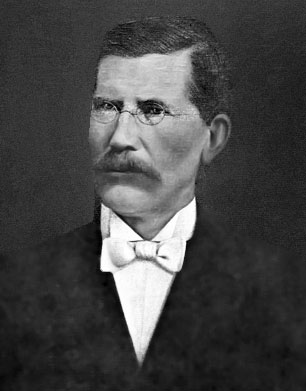 |
|
Dr.
John P.
Wall,
Tampa's 16th
mayor
1878 to 1880 |
That point was reached on
Oct. 4, by which time Dr.
Wall had seen a total of
seven cases. Two patients
had died, and albumin was in
the urine of two other
cases. Summoning the board
of health, Wall announced
his diagnosis. He noted that
this was received “with many
objections, on the part of
the other members, on the
ground that the city was
very healthy, hardly anybody
was sick, and that very few
deaths had occurred,
certainly not as many as
might be expected in so
large a population.” Wall
conceded that there was no
epidemic yet, but he hoped
to avoid one by depopulating
the city and by urging all
non-immunes to flee. He
wanted this implemented
before the news leaked out
by wire, so that those
leaving would not be denied
refuge everywhere they went.
The Yellow Fever epidemic is
continued after the electric
lighting of Tampa below.
|
TAMPA INTRODUCED
TO ELECTRIC
LIGHTING - The
Tampa Journal -
Jan. 5, 1887 - The
lengthy article
begins in all
caps:
UPWARD AND
ONWARD WE
MOVE!
ELECTRIC
LIGHTS TO BE
PUT IN THE
CITY AT
ONCE. THE
WATER-WORKS
AND HOTEL
SOON TO
FOLLOW, AND
OUR CITY BY
THE SEA TO
TAKE HER
PLACE AMONG
THE FIRST OF
THE STATE.
Steps have been
taken to install
an Electric
Machine in Tampa
with enough
power to meet
all of Tampa's
present needs
for more and
better light.
F. B. Pickering
had come to
Tampa from
Jacksonville,
representing
several
prominent
electric light
companies in the
country. He was
displaying
incandescent
lighting and
various sources
of power in
order to induce
citizens to form
a joint stock
company to put
an electric
plant in Tampa.
His main
obstacle was
finding a
suitable engine
to run the
little dynamo he
carried with
him. His first
attempt was to
light the store
of Herman
Glogowski, but
lack of steam
power on his
first try was
not satisfactory
to him, but it
did convince
witnesses that
there was merit
in the machine
he was showing.
Pickering then
made arrangement
to use an engine
in a local
machine shop, so
moved his
display there.
When all was
ready, he
invited
prominent
citizens and
members of the
City Council to
see the light
made with
increased
power. The
witnesses were
"exceedingly
pleased and
pronounced it
very fine
indeed, but
unfortunately,
only a few
persons saw
it." So
Pickering found
it difficult to
organize a
stockholding
company.
He then became
discouraged and
went to Ybor
City to try to
convince Mr.
Ybor and others
to install an
electric plant
there.
Introduced to
Mr. Manrara by
the author of
the article, he
explained the
workings, cost,
etc, of the
system. Not
having been at
the Tampa
demonstration,
the author was
convinced of the
process and
invited
Pickering to
meet with Capt
John T Lesley,
Robert Jackson,
and the Tampa
Journal editor,
W. N. Conoley,
the next
morning. After
hearing his
presentation,
the men said
that if he could
make a
satisfactory
display of the
light to them,
they would be
prepared to
close a contract
with him for a
plant in Tampa.
This one done
and at once an
agreement was
made between
Lesley, Jackson
and Conoley, and
Pickering to put
in a FIVE
HUNDRED
INCANDESCENT
LIGHT MACHINE OF
THE WESTINGHOUSE
PATENT &
MANUFACTURER,
AND A
THIRTY-FIVE ARC
LIGHT MACHINE of
the American
Company's
manufacture,
(Fuller-Wood
patent).
[Read about "The
War of the
Currents,"
the battle
between Thomas
Edison,
proponent of
Direct Current,
and George
Westinghouse,
proponent of
Alternating
Current, and the
role that
inventor Nikola
Tesla played for
both men, at
Smithsonian.com.
From the
article: Both
men knew there
was room for but
one American
electricity
system, and
Edison set out
to ruin
Westinghouse in
“a great
political, legal
and marketing
game” that saw
the famous
inventor stage
publicity events
where dogs,
horses and even
an elephant were
killed using
Westinghouse’s
alternating
current. The two
men would play
out their battle
on the front
pages of
newspapers and
in the Supreme
Court, in the
country’s first
attempt to
execute a human
being with
electricity. ]
Mr. Pickering
then left for
Pittsburgh to
buy all the
machinery
necessary. A
partial canvass
of the city
indicated that
all the lights
would be spoken
for soon after
the plant was in
operation and
expectations
were that within
the next 40 days
everything would
be set up and in
operation. They
hoped that the
City Council
would make a
contract for
lighting as up
until this
point, no effort
had been made.
"It will not
only lessen the
cost of
insurance for
all those who
use it, but will
give us the best
lighted place
south of
Jacksonville,
and puts Tampa
at once among
the progressive
places of our
now
rapidly-progressing
state.
After the
lighting of
Tampa, efforts
would turn to
"the Grand
Hotel". "With
any determined
and united
effort, we can
build a house
second to none
in Florida. Why
not do it and do
it at once?"
The lights and
hotel would
bring the
necessity of a
water works, and
with these three
factors in the
make up of a
live and
progressive
city, we will
have reached a
tone and dignity
that will make
some of our
sister cities
wince. Let
every one be up
and at work for
to-day is
Tampa's
opportunity.
Let no man say
"We can't." See
the entire
article here,
click the image
again to see it
full size.
In the midst of
the Yellow Fever
epidemic, the
City of Tampa
began converting
from kerosene
street lamps to
electric. Below
from "Tampa
Early Lighting
and
Transportation,
by Arsenio M.
Sanchez, THE
SUNLAND TRIBUNE
Volume XVII
November, 1991
Journal of the
TAMPA HISTORICAL
SOCIETY.
|
An
early
Tampa
Electric
Company
(not
the
present
Co.)
was
organized
in
Tampa
on
January
29,
1887.
About
three
months
later
the
company
brought
the
first
Electric
lights
to
the
city
of
Tampa.
A
small
Westinghouse
generator
was
brought
in
and
two
arc
lights
were
erected,
one
at
the
corner
of
Franklin
and
Washington
Streets;
and
one
in
front
of
the
brand
new
"Dry
Goods
Palace."
Tampa’s
first
"light
show"
took
place
Monday,
April
28,
1887.**
Word
got
around
and
people
came
from
all
parts
of
town
to
witness
the
event.
The
Tampa
Journal
recorded
the
occasion
by
saying,
"The
amazed
throng
could
hardly
believe
that
the
stygian
darkness
could
be
dispelled
so
miraculously
by
current
coming
through
a
wire.
Dazzling
bright
though
these
arc
lights
were,
they
were
at
best
a
qualified
success,
sputtering,
crackling
and
hissing,
they
went
out
with
dismaying
frequency.
**The
date
given
by
Mr.
Sanchez
was
actually
the
date
of
the
Tampa
Journal
article,
which
below
can
be
seen
that
the
date
of
the
lighting,
"last
Monday
night"
would
have
been
April
25th. |
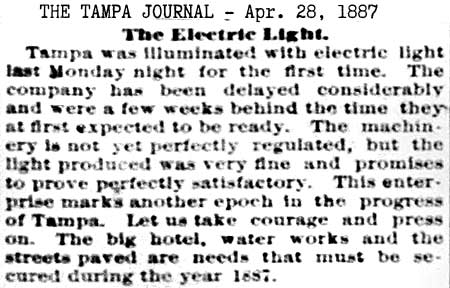 |
|
The
above
reference
to
"the
big
hotel"
was
H.
B.
Plant's
Tampa
Bay
Hotel. |
FIRST LIGHTING
CONTRACT
At a special
City Council
meeting on Aug.
31, 1887, W. N.
Conoley of Tampa
Electric Light &
Power presented
his proposal to
those present.
The proposal was
for arc or
incandescent
lighting at the
same price they
would offer to
private
citizens. He
proposed 12 to
14 lights at a
rate of 60 cents
per night under
the stipulation
that the city
would enter into
a 10-year
contract with
him.
Judging from
what they saw,
the City fathers
on Sept. 13,
1887 met with
the City Council
and awarded the
fledgling
company a
ten-year
contract to
provide street
lighting. Twelve
arc lights at 60
cents a night to
be provided.
|
|
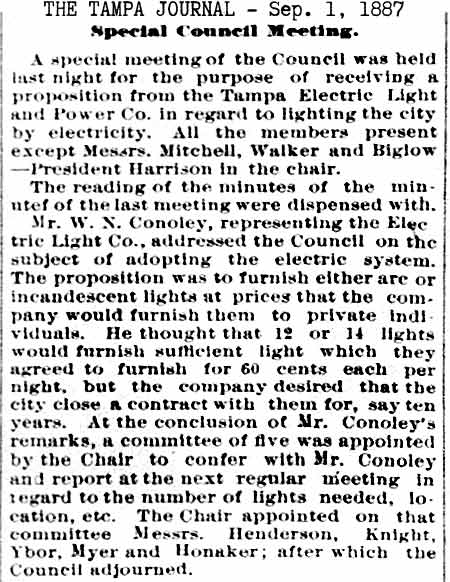 |
The city council
accepted the
offer by Tampa
Electric Light
Co. to furnish
the city with
electric street
lamps. |
|
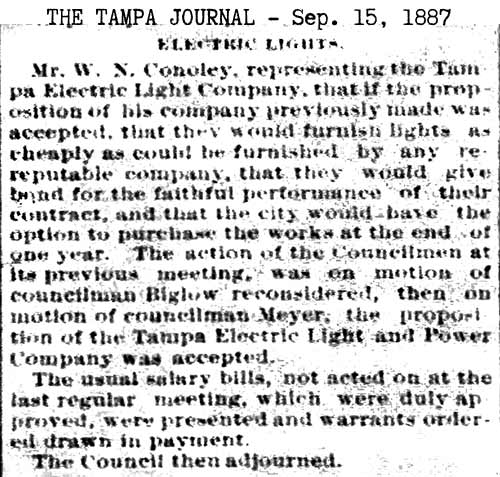 |
|
|
|
|
On Sep. 22,
1887, the City
Council passed
an ordinance
allowing Tampa
Electric Light &
Power to
contract with
the City of
Tampa. |
Sep. 29, 1887 -
The Street
Committee
announced the
locations of
eight new street
lights. |
|
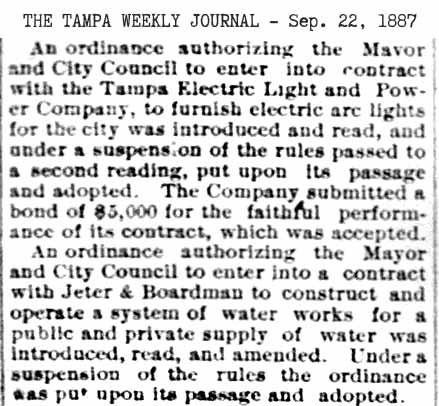 |
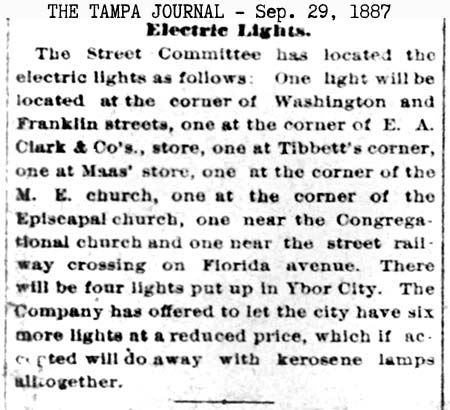 |
|
|
|
|
|
In the end, Wall prevailed.
On October 5, he began
spreading the news to local
citizens, while the board of
health went beyond his
suggestions and declared
that epidemic proportions
had already been reached. A
few of Tampa’s citizens had
fled even before this date.
On October 4, a Jacksonville
paper reported that a
refugee from Tampa died at
Palatka and around one
hundred of Palatka’s
citizens had, in turn, fled
from that City. Fear, it
seems, was as contagious as
yellow fever.
This news incited panic in
people which caused many to
flee Tampa. Since a person
who is infected with the
illness does not immediately
know they are sick, it was
very easy for the illness to
spread to other cities in
Florida. While some people
did flee the city, many
others decided that it would
be better to stay put. From
the remaining Tampans, many
of them kept diary entries
of their experiences with
Yellow Fever. In the diary
of E.E. and E.B. Johnson,
one can read about a man who
loses his father to the
disease coupled with the
writer himself contracting
the dreaded disease.
On October 6, 1887, the
Tampa Journal admitted that
panic gripped the city.
“There is no use disguising
the fact that the people of
Tampa are panic stricken,”
the Journal observed.
“Whether our fears are
well-founded remains to be
determined.” The newspaper
mentioned the “general and
exciting exodus” and
reported that scores of
people had left on the
northbound train the
previous evening. However,
the Journal tried to
minimize the threat by
stating “the fact that we
are having an epidemic of
Dengue fever.” Conceding
that “three cases of an
aggravated type. . . have
proved fatal,” the paper
declared that “many people
have jumped to the
conclusion that we have
Yellow fever.”
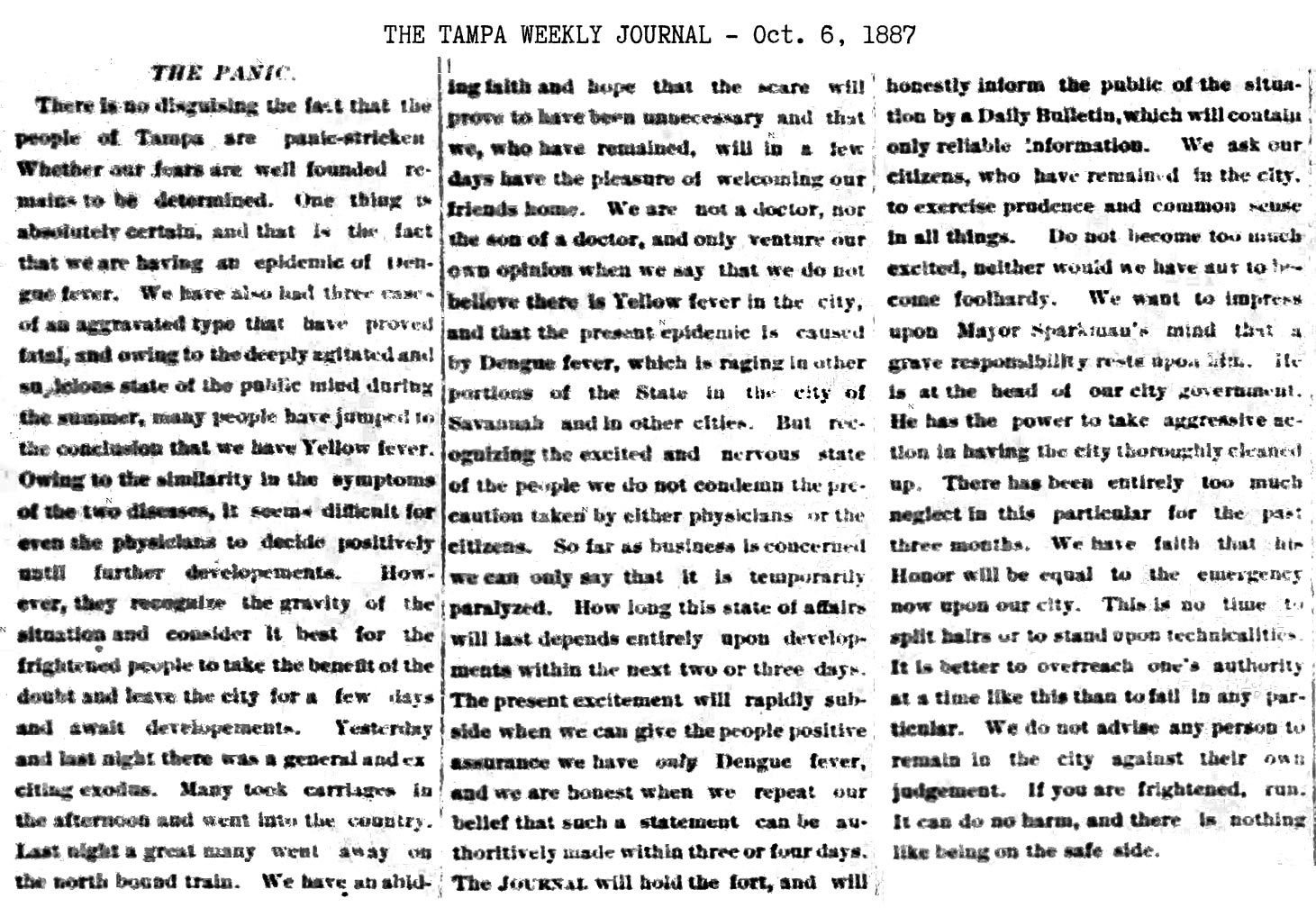
The Journal emphasized that
dengue was raging throughout
Florida and in Savannah,
implying yet again that
Tampa’s epidemic was due to
the milder, less feared
disease. “Do not become too
much excited,” the editor
advised residents who had
not fled, but he added: “If
you are frightened, run. It
can do no harm, and there is
nothing like being on the
safe side.”
On October 8, Tampa’s
epidemic made the front page
of the New York Times.
Noting the “wild excitement”
in the city, the Times did
not doubt that the disease
was yellow fever. “The fever
seems to have supplanted
reason, no one seemingly
knowing what treatment to
adopt, and everyone, even
physicians, seeking safety
in flight,” the Times
reported. “The city is now
virtually deserted. . .The
panic was so great, that, in
many instances, thousands of
dollars worth of property
was left unprotected.”
 |
|
The Oct. 20,
1887 article
below says Tampa
was visited by a
Key West doctor
who confirms a
Yellow Fever
epidemic in
Tampa. The city
has been
quarantined thus
causing a great
loss of business
and employment.
They solicit
material support
from the people
and businesses
of New Orleans,
to be sent to
A.C. Wuerpel in
Tampa. |
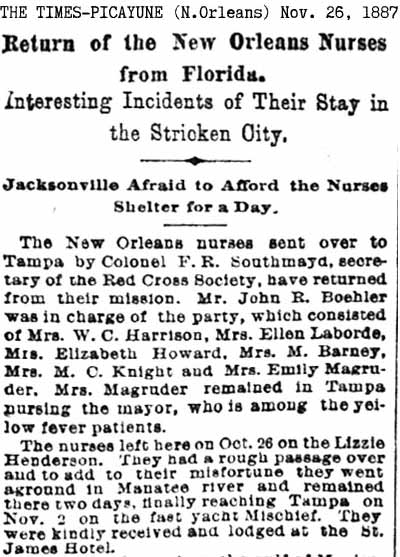 |
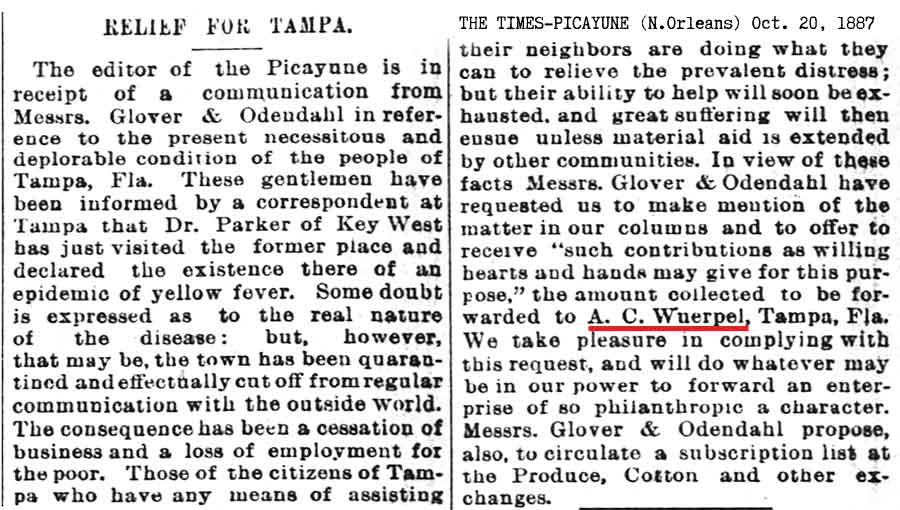 |
|
The Nov. 26,
1887 article at
above right
tells of Red
Cross nurses
that were sent
to Tampa are
leaving by way
of Jacksonville.
It also tells of
the quarantine
surrounding
Tampa being
enforced by men
with shotguns.
Also included is
a letter
received from
Hugh
Macfarlane. See
the whole
article with
more info and
details..
When the image
opens, click it
again to see it
full size. |
|
Altogether, in the year 1887 it is
estimated by Dr. John P. Wall that there
were about 1000 cases of Yellow Fever in
Tampa with about 100 deaths, however it
is now thought that this number could be
grossly underestimated. Dr. Wall's
intensive study of the disease had led
him to conclude in 1873 that the cause
was the tree-top mosquito. His findings
were ignored and ridiculed by proponents
of filth being the cause. Dr. Wall
apparently did not pursue the
mosquito-borne explanation diligently
and so publically, he appears to have
gone with the general consensus. In
1900, Dr. Walter Reed came to the same
mosquito-borne conclusion, and
historically gets most of the credit for
finding the cause of Yellow Fever.
Read more details about the Yellow
Fever epidemic in Tampa, 1887,
at “A SNEAKY, COWARDLY ENEMY”:
TAMPA’S YELLOW FEVER EPIDEMIC OF
1887-88 by Eirlys Barker.
Read about Dr. John P. Wall, the
first to identify the mosquito as
the carrier of Yellow Fever, in Florida's
Past: People and Events That Shaped
the State, Volume 1 By Gene M.
Burnett
|
TAMPA'S NEW WATER SUPPLY
When
Jacksonville was hit by yellow fever, northern
capitalists began to shun Florida investments. The
Jeter-Boardman company had trouble getting money and
months passed before it could proceed with Tampa's
water works. Finally, two 1300-foot artesian wells
were drilled at Sixth Street and Jefferson Avenue, a
110,000-gallon stand pipe was constructed, and a
pumping station was completed. 'Water was turned on
April 20, 1889. Now, for the first time, Tampa
people got water merely by turning on a faucet.
|
In 1888, the
Jeter-Boardman Waterworks built Tampa's
first pumping station at 6th Ave (a.k.a.
Henderson St.) and Jefferson St,
caddy-corner from the 2nd
home of Hillsborough County High School which
was established there in 1886.
Completion of the water system made
possible an effective fire fighting
organization. Prior to that time Tampa's
firemen had been seriously handicapped
by lack of an adequate water supply. |
|
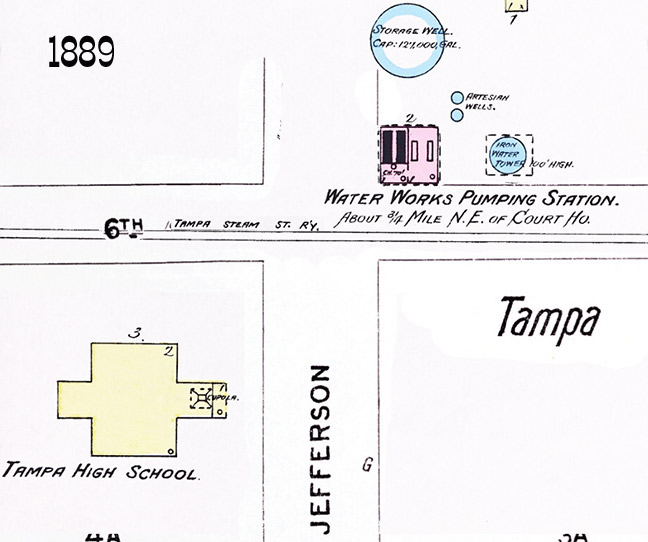 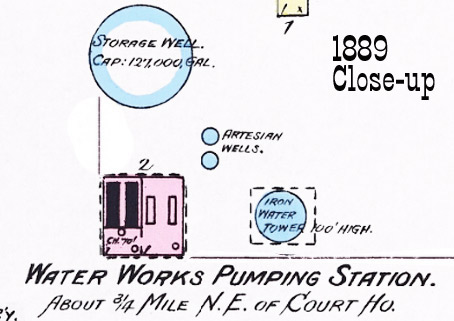
The 1889 maps above (with 1899 streets
added) show Tampa's first pumping
station. It consisted of a deep storage
well and an iron storage tank on a 100
ft. high tower. A detailed description
of the equipment is provided below. The
high school seen in the above left map
was the 2nd
home of Hillsborough (County) High
School.
|
Description of the new water plant supply
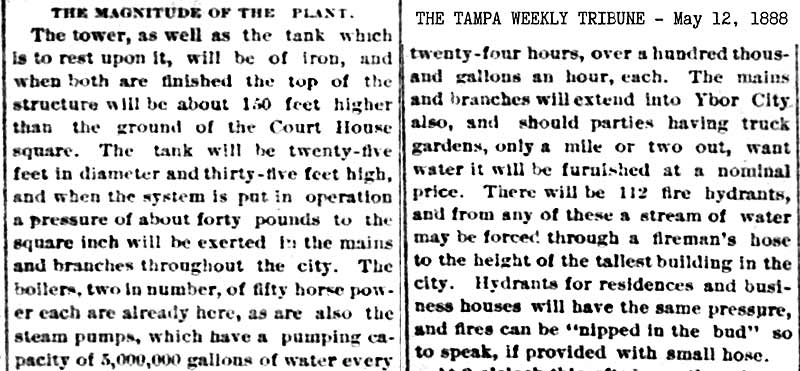
See
a more detailed history of Tampa's Waterworks here
at TampaPix.
THE
VOLUNTEER FIRE DEPARTMENT IS ESTABLISHED BY CITY
ORDINANCE NO. 40, April 22, 1889
While
plans were being made to build a new city hall/fire
department headquarters at Lafayette St. and Florida
Ave, the city council passed ordinance No. 40 on
April 22, 1889 authorizing the establishment of a
volunteer fire department.
Section 6 as to the election of a Chief: The
City Council would select the Chief until four fire
companies have been organized and accepted by the
Council, at which point the fire companies would
nominate a candidate for the Council to confirm and
serve for two years. ("nominate a candidate" in
those days meant to actually select the
office-holder.)
Section 7 provided for the selection of as many
Assistant Chiefs deemed necessary by the Council.
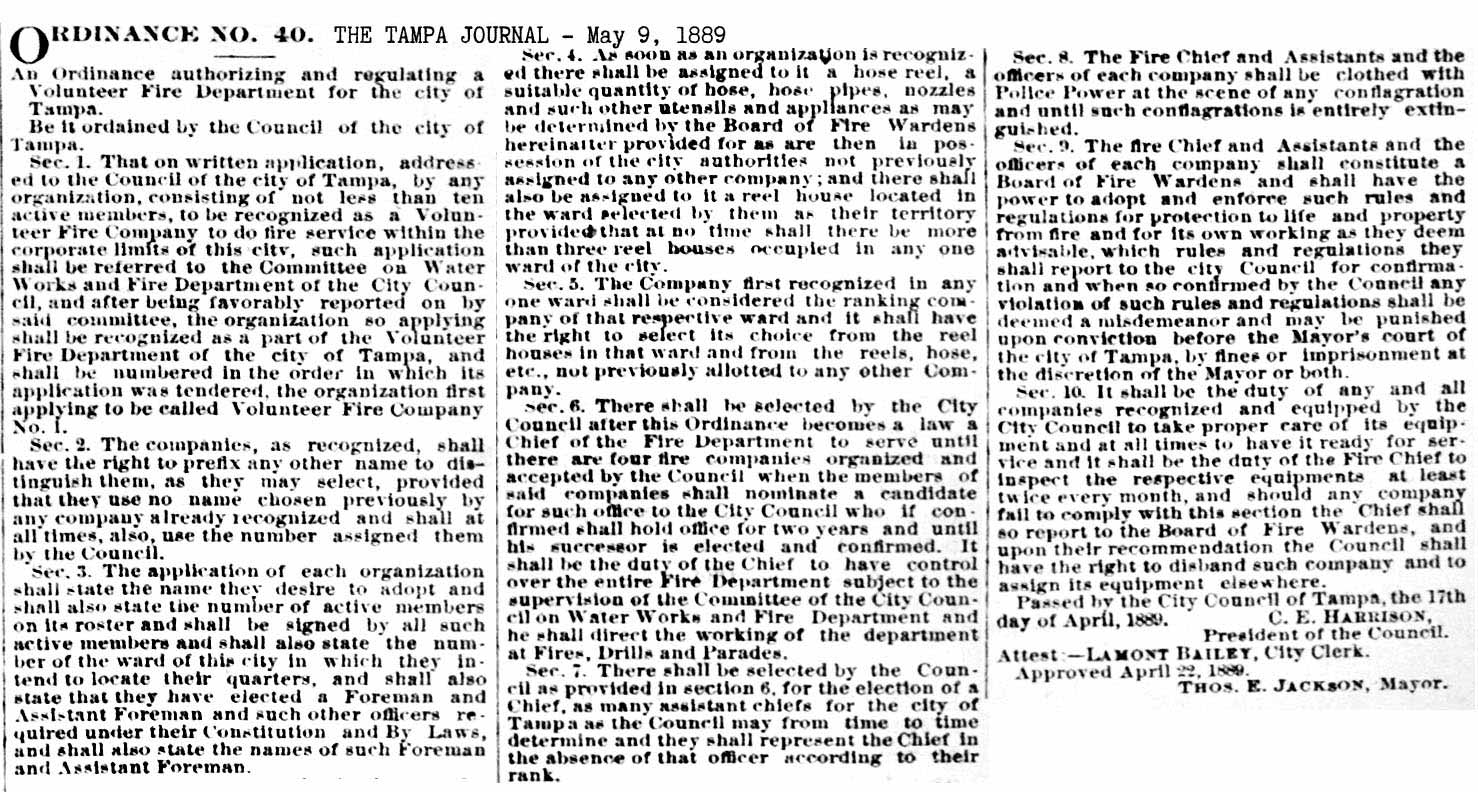
Click the article to see it larger.
|
As
permitted under Section 2, fire
companies were formed with names as Alert
Hose Co.No.1, Resolute Hose Co. No.2, Active
Hose Co. No. 3, Protection Hose
Co. No. 4, Phoenix Hose Co.
No.5, and Mirta Hook and Ladder Co. No.
1, which was named for the youngest
daughter of Vicente Martinez-Ybor. |
|
D.B. McKay in his Pioneer Florida
column of Aug 23, 1959, claims seven companies
were formed in the volunteer dept.--Alert, Resolute,
Phoenix, and Mirta, which are named
in the May 29, 1889 fire chief election
article below, but McKay & Grismer add
three not mentioned: Vigilant, Relief,
and Humanity, and does not
mention Active and Protection hose
companies. The discrepancy can be
attributed to not specifying when these
companies were started. TAMPA'S
BRAVEST website uses
McKay's/Grismer's list as well. McKay
also attributes the "Mirta"
name (erroneously) to Ybor's wife instead of his
youngest daughter.
At right: Francisco Puglisi, the first
fire captain in Ybor City history. The
honor was given to him when the Cubans
of the first volunteer fire unit
selected him to head the Mirta Hook &
Ladder volunteer company in 1888. The
unit honored Mr. Ybor's youngest
daughter. In 1886, the four small steam
engines that ran on narrow-gauge rails
between Tampa and Ybor City which pulled
the streetcars were named for Ybor's
daughters Jennie, Mirta and Eloise,
along with Mrs. Ignacio Haya--"Fannie."
|
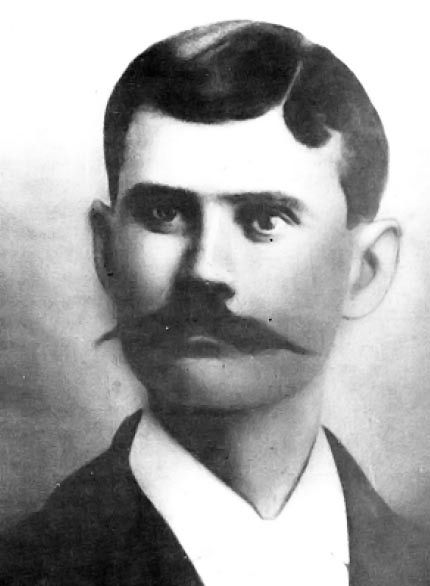
Photo courtesy of The Sunland Tribune,
Journal of the Tampa Historical Society,
Vol. 3, No. 1 - Nov. 1977, Hampton Dunn,
editor, "The
Italian Heritage in Tampa" by Tony
Pizzo. |
It would appear
that the historic marker is a bit premature in
its claim.
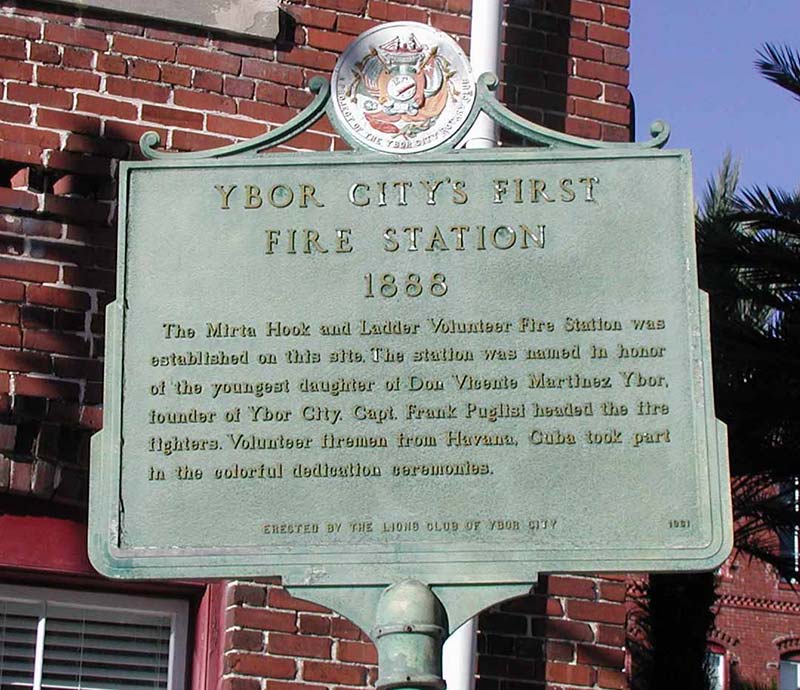
Below is a satellite view of the location of the
historic marker. At this time, the Mirta
company was V. Martinez-Ybor's private fire
fighting company which protected this area
including his factory.
Place your cursor on the map to see this area
from the April 1889 Sanborn fire insurance map.
There apparently was no fire station here in
April 1889 or before then, where the volunteer
firemen worked their shifts. There was a
small wooden structure that housed the chemical
engine which can be seen on the right.
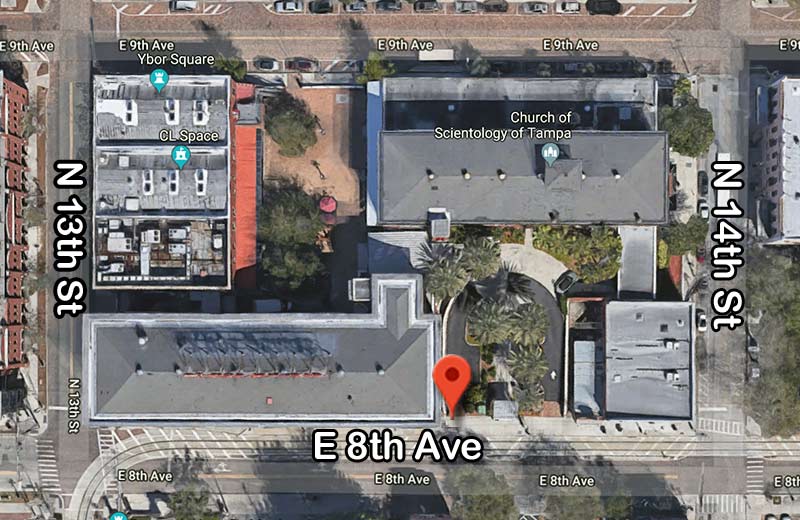
A close up of the
April 1889 map reveals the size and equipment
for the Mirta Company at this time.
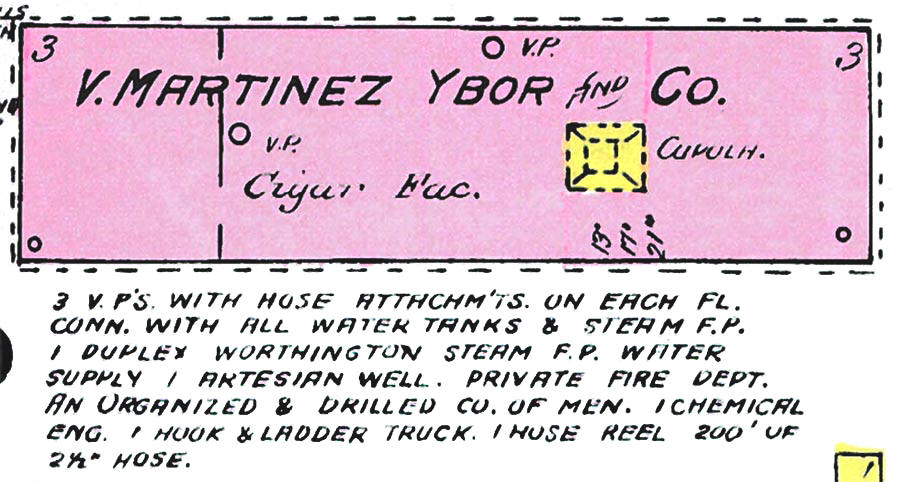
The index on page
1 of the map also provides a description of the
Tampa volunteer fire department, then the
department's equipment in Ybor City (2 hose
carts, 1 hook & ladder truck, 1,000 ft. of
hose)to be used with Ybor's private fire company
("An organized & drilled private co. of men, 1
chemical engine, 1 hook & ladder truck, 200 ft.
of 2.5-inch hose.)
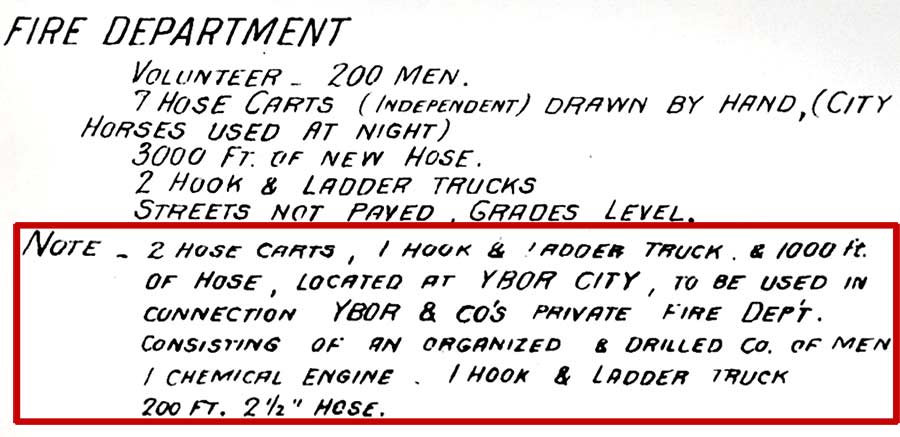
The Mirta Company
fire station was completed and dedicated on Aug.
11, 1890, two months after Chief Wuerpel had
resigned and A. J. Harris had become the Acting
Chief of the volunteer dept.
See the feature about A. J. Harris for the article
about the dedication
of the Mirta fire
house.
The historic
marker should read:
YBOR CITY'S FIRST FIRE STATION, 1890
"The Mirta hook & ladder fire DEPARTMENT was
established on this site as V.M. Ybor's private
fire fighting company. On Aug. 11, 1890,
their first fire station was dedicated for the
use of the Mirta Hook & Ladder Co. and the
Vigilant Hose Co.

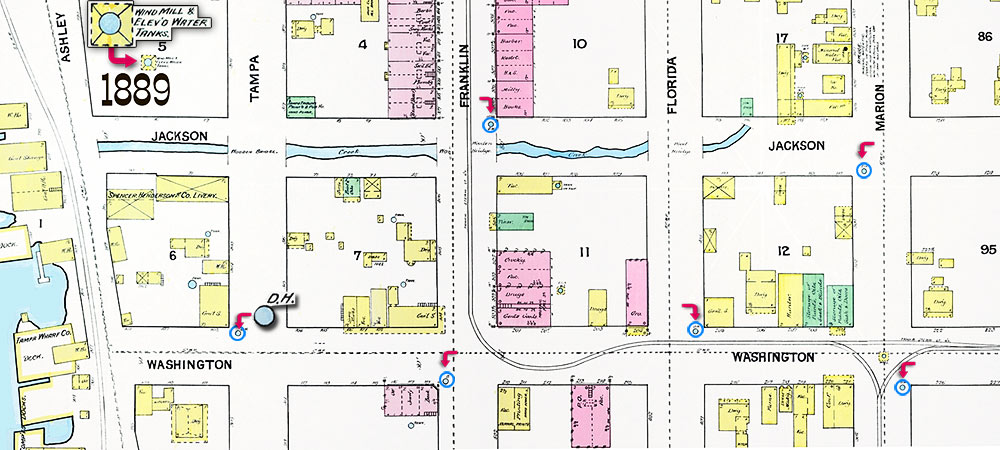
In
1889 there were six wells in the heart of the
business district.
1889 Sanborn fire insurance map from the UF
digital maps collection
|
TAMPA PLANS ITS FIRST CITY
HALL
On April
23, 1889 a bond election was held for
the issuance of $100,000 of 7% bonds for
internal improvements which included the
construction of a city hall, fire
station and street paving work. The
result of the election was that 489
votes were cast in favor of the bonds, 7
against, and 6 marked "no bonds." The
election was ratified on April 26 by the
city council and the bonds sold to W. N.
Coler & Co. of New York on May 15, 1889,
and delivered through T. C. Taliaferro
on June 17th.
See more about the planning and
construction of Tampa's first dedicated
City Hall & Fire Headquarters here at
TampaPix.
WUERPEL
APPOINTED CHIEF WITH HARRIS 1ST
ASSISTANT AND RODRIGUEZ 2ND ASSISTANT
On May 5,
1889, Augustus "Gus" C. Wuerpel was
chosen by the City Council as Fire Chief
with A. J. Harris and Manuel Rodriguez
serving as first and second assistants,
respectively. |

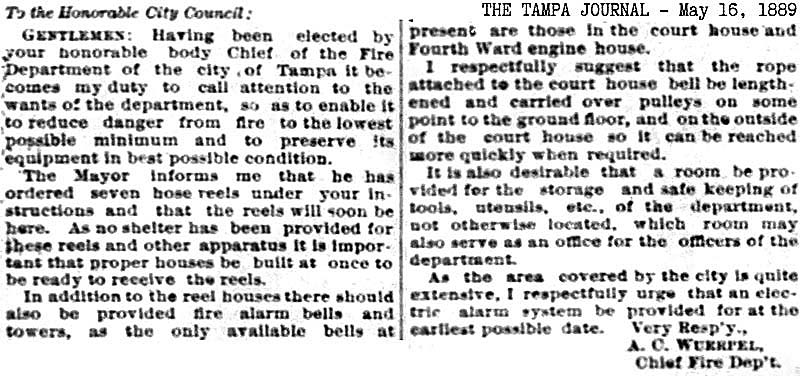
|
In
addition to the reel houses, Wuerpel
asked for provision of fire alarm bells
and towers, as the only ones at the time
were in the courthouse and the Fourth
Ward engine house. He suggested that
the rope attached to the courthouse bell
be lengthened and carried over pulleys
so they would extend to the ground
floor, and on the outside of the
building so they could be reached more
quickly. Also needed was a "desirable
room" be provided for the storage and
safe keeping of tools, utensils, etc.
not already located in one, with a room
to serve as an office for the officers
of the department. Because of the large
area the city covered, he urged the
council to provide an electric alarm
system as soon as possible.
|
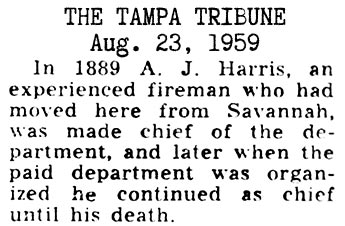 At
this point, in Karl Grismer's History
of Tampa, Grismer makes an erroneous statement,
as does D.B. McKay in Pioneer Florida: At
this point, in Karl Grismer's History
of Tampa, Grismer makes an erroneous statement,
as does D.B. McKay in Pioneer Florida:
On May
18, 1889, A. J. Harris was appointed
chief and competitive fire drills were
held regularly. An electrical fire alarm
system was installed December 9..."
In the
Aug. 23, 1959 Tampa Tribune, D. B. McKay
recounts his memories of the volunteer
fire department in a Pioneer Florida
column "Chief Soaked in Jackson Street
Ditch Water." About halfway through the
column, McKay made the same erroneous
statement as you see at right. No
surprise since D.B. McKay was Grismer's
editor. McKay's memories at that point
were 70 years old.
|
|
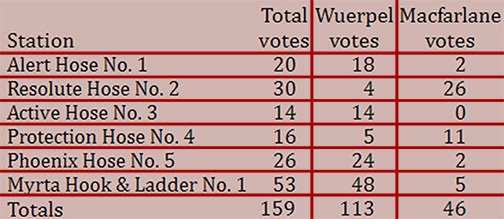
ELECTIONS
On May
29, 1889, as set forth in Ordinance No.
40, elections were held by the six fire
companies around the city to select
their chief. Wuerpel was chosen over
G. R. Macfarlane by a margin of 67
votes. A. J. Harris and Manuel
Rodriguez were elected as first and
second assistants, respectively,
with no opposition.
Also
on May 29, 1889, the City Council
amended the water works ordinance to
provide 27 additional hydrants.
Councilman Fred Salomonson (who
would later serve 3 non-consecutive
terms as Mayor beginning in March,
1893) offered a resolution that the
Tampa Journal republish the article
which was recently in the paper
about the Board of Public Works and
the permanent chairman pro-tem which
was adopted.
|
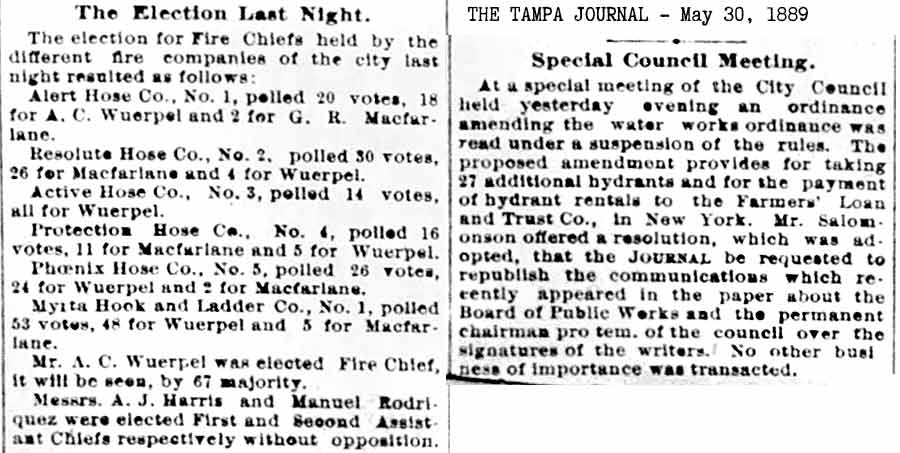 |
|
 At
Left, the Fire Alarm call box on the corner of Lafayette St.
and Florida Avenue, in front of the 1890 City Hall/Fire
Dept. in 1905.
At
Left, the Fire Alarm call box on the corner of Lafayette St.
and Florida Avenue, in front of the 1890 City Hall/Fire
Dept. in 1905.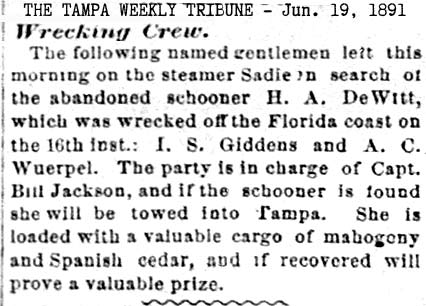
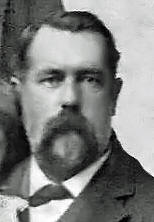
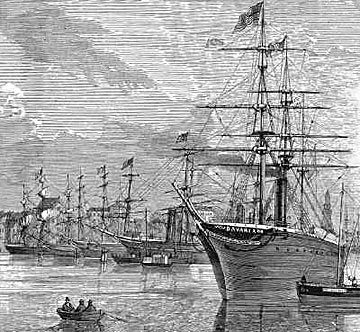























 The
City of Tampa was established on Jun 2,
1887 when under special act of the state
legislature, the Governor approved a
bill that granted the city of Tampa a
new charter, abolishing the town
governments of Tampa and North Tampa.
Section 5 of the charter provided for a
city-wide election for mayor, eleven
councilmen and other city officials, to
be held on the 2nd Tuesday in July. The
new charter also greatly expanded the
corporate limits of the city. Tampa now
took in North Tampa, Ybor City and some
land on the west side of the
Hillsborough River.
The
City of Tampa was established on Jun 2,
1887 when under special act of the state
legislature, the Governor approved a
bill that granted the city of Tampa a
new charter, abolishing the town
governments of Tampa and North Tampa.
Section 5 of the charter provided for a
city-wide election for mayor, eleven
councilmen and other city officials, to
be held on the 2nd Tuesday in July. The
new charter also greatly expanded the
corporate limits of the city. Tampa now
took in North Tampa, Ybor City and some
land on the west side of the
Hillsborough River.







 Leading
citizens considered it an
over-reaction to the
situation when Jacksonville
inflicted a quarantine on
all people from Tampa. This
action was protested by the
editor of the Tampa Weekly
Journal, Harvey Cooper, who
claimed that it hurt the
“Hotel Interest.” Cooper
seemed especially concerned
about Henry Plant’s plans
for building a magnificent
hotel at Tampa to attract
thousands of tourists--and
millions of dollars--every
winter. In defense of
this vision, Cooper
sarcastically reported that
the city was no longer in a
state of panic, and “the
people are laughing at their
own foolishness...Only one
death in Tampa since--the
Lord only knows when, and
that occurred last Sunday.
It was a mule. It would be
dangerous for Jacksonville
to lift their quarantine
against Tampa yet awhile."
Leading
citizens considered it an
over-reaction to the
situation when Jacksonville
inflicted a quarantine on
all people from Tampa. This
action was protested by the
editor of the Tampa Weekly
Journal, Harvey Cooper, who
claimed that it hurt the
“Hotel Interest.” Cooper
seemed especially concerned
about Henry Plant’s plans
for building a magnificent
hotel at Tampa to attract
thousands of tourists--and
millions of dollars--every
winter. In defense of
this vision, Cooper
sarcastically reported that
the city was no longer in a
state of panic, and “the
people are laughing at their
own foolishness...Only one
death in Tampa since--the
Lord only knows when, and
that occurred last Sunday.
It was a mule. It would be
dangerous for Jacksonville
to lift their quarantine
against Tampa yet awhile."
 By
September 29, Wall had seen
five suspicious cases,
including two that other
physicians had diagnosed as
bilious remittent fever.
However, he deemed it
“prudent to await further
developments,” for “it is a
very serious thing to
announce the presence of
yellow fever.” Of the
suspicious cases in
September, only Turk’s had
been fatal which suggested
that dengue--a non-fatal
disease with symptoms
similar to yellow
fever--might have been the
cause. Therefore, Wall
continued to observe
possible cases, and he did
not make the fateful
declaration until all his
doubts had disappeared.
By
September 29, Wall had seen
five suspicious cases,
including two that other
physicians had diagnosed as
bilious remittent fever.
However, he deemed it
“prudent to await further
developments,” for “it is a
very serious thing to
announce the presence of
yellow fever.” Of the
suspicious cases in
September, only Turk’s had
been fatal which suggested
that dengue--a non-fatal
disease with symptoms
similar to yellow
fever--might have been the
cause. Therefore, Wall
continued to observe
possible cases, and he did
not make the fateful
declaration until all his
doubts had disappeared.






















 At
this point, in Karl Grismer's History
of Tampa, Grismer makes an erroneous statement,
as does D.B. McKay in Pioneer Florida:
At
this point, in Karl Grismer's History
of Tampa, Grismer makes an erroneous statement,
as does D.B. McKay in Pioneer Florida: 

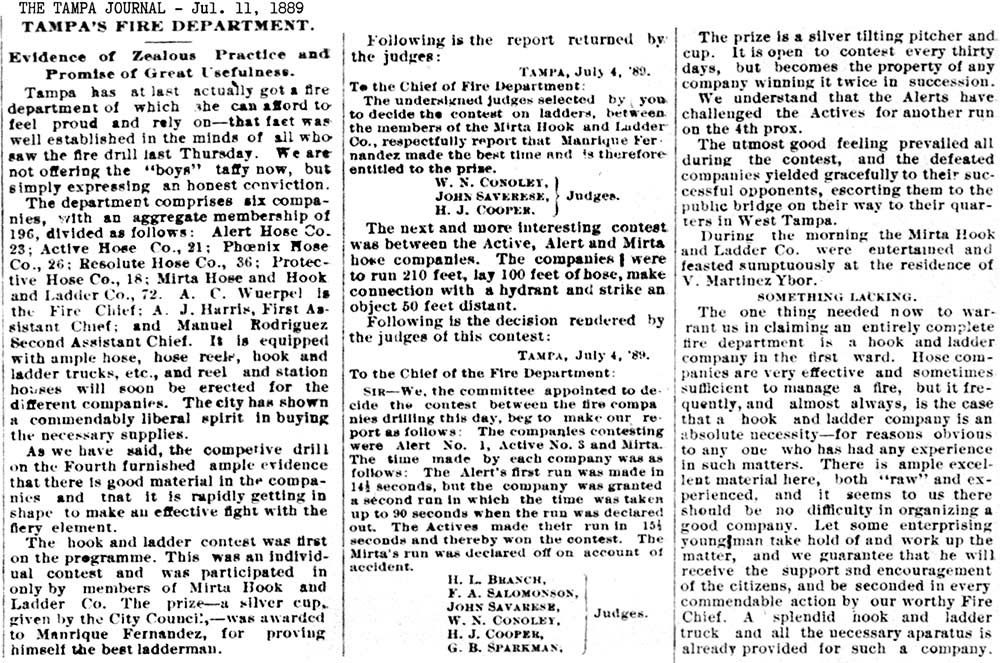


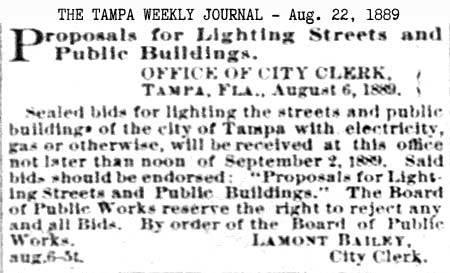
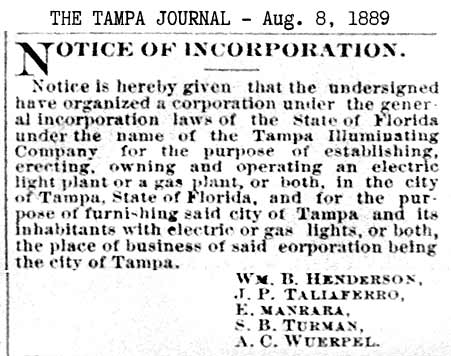 Around
this time, Chief Wuerpel decided to devote more time and
attention to his businesses as its increasing demands
required it, so he tendered his resignation to the council.
Around
this time, Chief Wuerpel decided to devote more time and
attention to his businesses as its increasing demands
required it, so he tendered his resignation to the council. 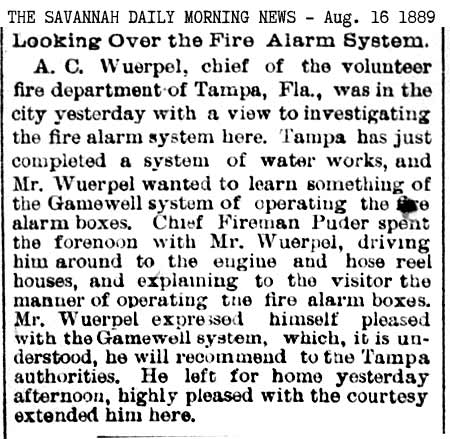
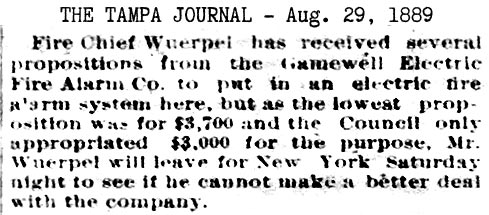
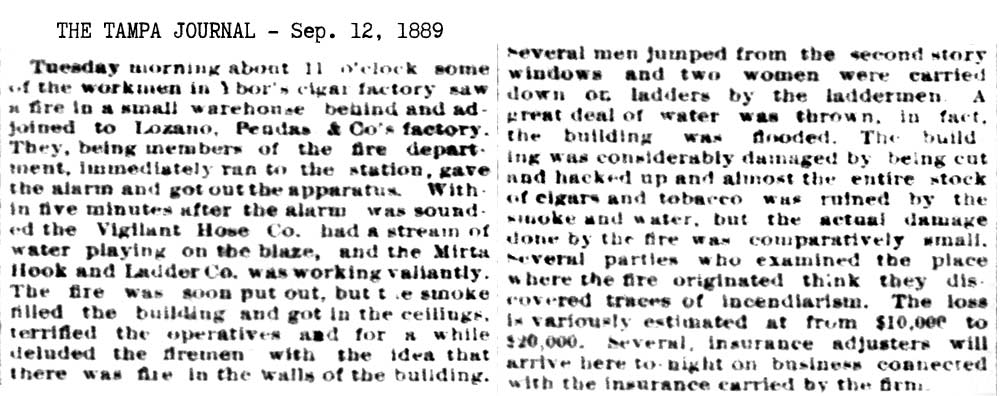
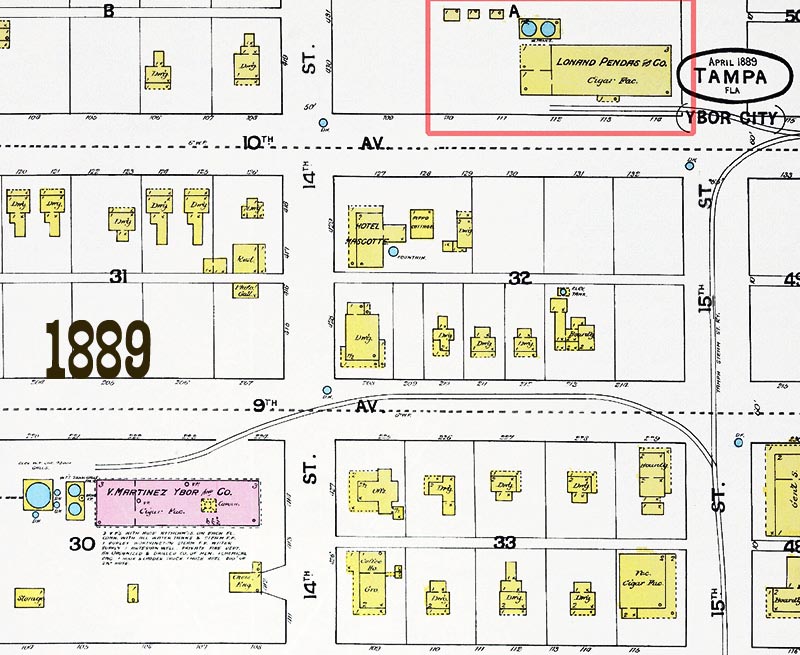
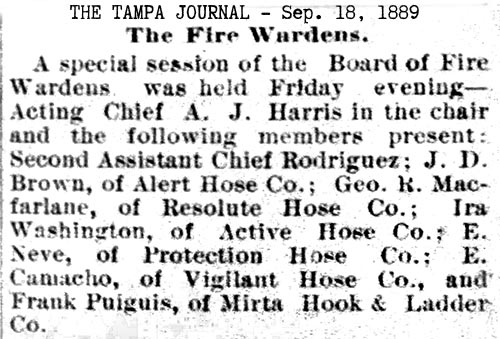
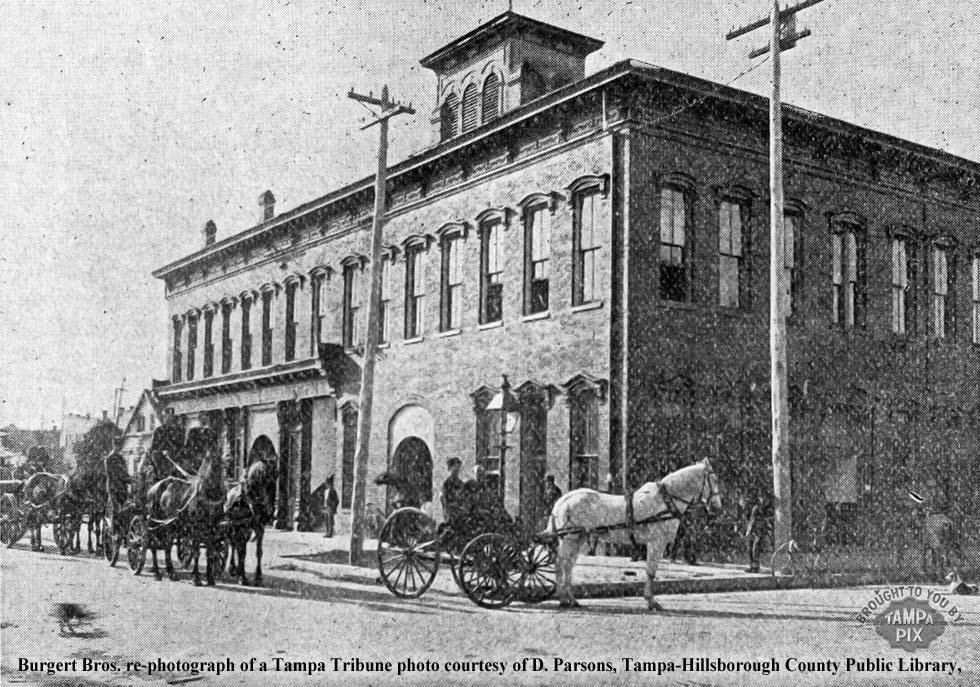
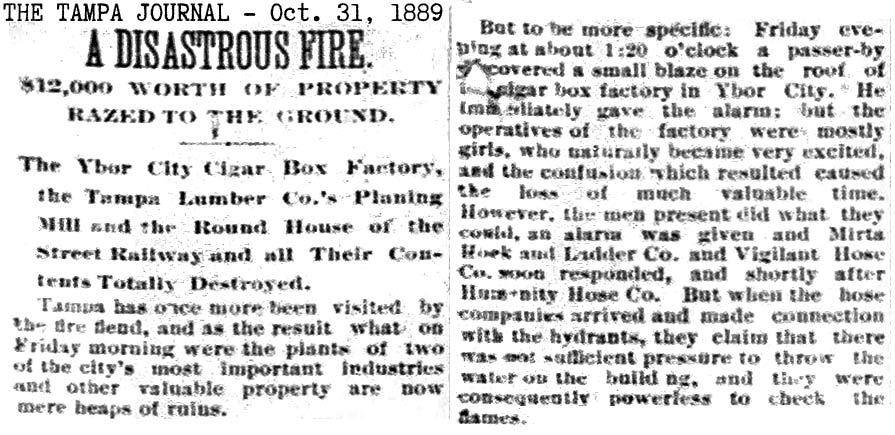
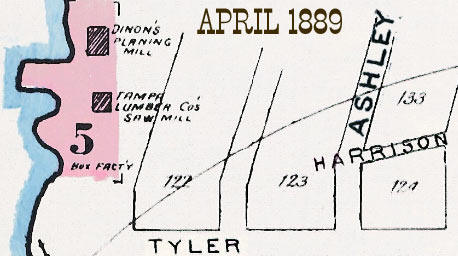 An
alarm was sounded at 1:20 p.m. when a passerby
saw a fire on a small portion of the Ybor City
Box Factory [which interestingly, is not in Ybor
City] so the Mirta Hook & Ladder Co., Vigilant
Hose Co., Humanity Hose Co. and Alert Hose Co.
responded. But upon connecting to the hydrant,
there was insufficient water pressure to spray
water on the fire. When the Alert Hose fire
company arrived from the First Ward, which had
come out in response to a general alarm sounded
from the courthouse bell, they also connected to
a hydrant but no water came from it.
An
alarm was sounded at 1:20 p.m. when a passerby
saw a fire on a small portion of the Ybor City
Box Factory [which interestingly, is not in Ybor
City] so the Mirta Hook & Ladder Co., Vigilant
Hose Co., Humanity Hose Co. and Alert Hose Co.
responded. But upon connecting to the hydrant,
there was insufficient water pressure to spray
water on the fire. When the Alert Hose fire
company arrived from the First Ward, which had
come out in response to a general alarm sounded
from the courthouse bell, they also connected to
a hydrant but no water came from it. 